10 1 13 21 16 24 17 15
3 19 14 25 20 23 11 22


10 1 13 21 16 24 17 15
3 19 14 25 20 23 11 22

This festive season, we’re thrilled to bring you something brand new and truly special – the very first Stir it up Advent Calendar. Created just for our readers, it’s our way of giving something back to you at the busiest time of year, while spreading plenty of festive cheer along the way.
Here’s how it works: the front cover of this month’s magazine is your advent calendar. Each day in December, simply open the numbered window, scan the QR code and unlock a chance to win an incredible prize. You’ll be taken online to enter that day’s giveaway – but remember, entries are only open for 24 hours unless otherwise specified, so don’t miss out! Winners will be chosen at random, giving you numerous chances to bag a treat.
We’ve teamed up with leading brands, all of whom have generously joined forces to share the festive spirit with you. Alongside them, Stir it up will also be adding some exclusive recipes and a few extra surprises of our own to make the countdown even more exciting.
So, what’s behind the doors? We don’t want to give too much away just yet, but you can look forward to prizes such as experience vouchers, chefs’ knives, training sessions, cookbooks and plenty more.
We know December is one of the busiest times of the year for caterers, and we wanted to create something fun, joyful and rewarding to share the load and say thank you for all that you do.
So go on – grab your magazine, scan today’s QR code and see what’s waiting for you.
!
A huge thank you to all the brilliant brands who have joined us in bringing the Stir it up Advent Calendar to life – your generosity and festive spirit have made this campaign possible!











Welcome to Stir it up’s festive extravaganza! To celebrate our first ever advent calendar, we’ve got a bumper issue bursting with inspiration for the festive season and beyond.
If you’re looking to maximise your Christmas menu with some waste-busting ideas, look no further than our Melting Pot and Making Ends Meet features, and don’t forget to check out what’s New from Country Range for the festive season. Find some seriously on-trend drinks ideas in the Category Focus and as always, don’t miss our customer features and sector articles to inspire your planning for 2026.
If you would like to get involved in a feature, we’d love to hear from you. Please email us

The Stir it up team


05
Fresh from the Kitchen The Latest Gravy Trends
17
Hospitality
Creating Memorable Experiences for Customers
19-22
Category Focus The Art of Designing an Irresistible Drinks Menu
37-40
Melting Pot Re-mixing Festive Leftovers





Toasted Marshmallow
Espresso Martini
Virgin Eggnog with Biscoff
Dulce de Leche Crumble-topped Cheesecakes
Gingerbread Caramel Shortbread
20 21 32
35
39 Leftover Turkey Quesadilla
53 Sausage Ragu


We’re entering peak gravy season, so there is no better time to explore the very latest trends to inspire your menu beyond the roast dinner. The craving for comfort food has catapulted gravy into the spotlight, with social media driving a revival in popularity amongst younger generations.
ELEVATED – Chefs aren’t necessarily reinventing the wheel but instead making their gravy extra good for the discerning diner. Bone marrow adds richness, and umami flavours are being enhanced with koji, miso, porcini mushrooms or black garlic. For a boozy warmth, red wine and stout remain popular, but whisky and IPA have also been spotted.
FLAVOUR TWISTS – As well as adding depth, we’re also seeing some trending flavours making their way into gravy, such as peri peri or pickle juice gravy.
ROASTS REIMAGINED – The classic roast dinner will never go out of favour, but it’s being given a modern spin – stuffed Yorkshire puds, burgers, wraps and tacos are being created – all featuring gravy as a key component, of course.
BURGERS, BUTTIES & BREAD – Gravy is becoming the latest condiment of choice –from dipping to completely dunking – gravy is the winning accompaniment to all manner of sandwiches and burgers. In more formal settings, bread is increasingly becoming a course in its own right, served with flavoured butters, beef dripping, and…yes, you guessed it – a side of gravy. Comfort food at its best.
SPUDS – Potatoes in all their forms are a match made in heaven for gravy. From poutine with a whole range of toppings, to loaded crunchies, not forgetting the humble chip butty, gravy plays a pivotal role in creating the ultimate winter warming treat.
PIZZA – Yep that’s right, nothing is off limits when it comes to gravy drenching! Replace the tomato base with gravy and top with roast chicken, stuffing and pigs in blankets, or beef, onions and horseradish. Fusion at its most comforting!
Poutine with french fries, gravy, and cheese curds



3RD NOVEMBER – WORLD SANDWICH DAY
Give your sandwiches a glow-up this World Sandwich Day! Recreate the Country Range Scampi Sandwich with a ‘crisp’, golden twist.
5TH NOVEMBER – BONFIRE NIGHT
Light up the night with something sweet! This Country Range Raspberry Treacle Tart recipe is the ultimate showstopper — a rich, nostalgic dessert that captures the cosy spirit of Bonfire Night.
13TH NOVEMBER – NATIONAL CHICKEN NUGGET DAY
Two celebrations in one bite! Mark National Chicken Nugget Day and World Vegan Month with Garden Gourmet’s flavour-packed Vegan Nugget Burger recipe. Vegan friendly comfort food.
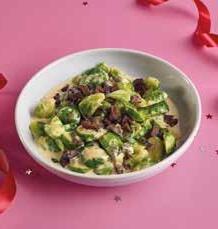
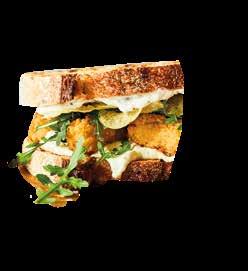


16TH JANUARY – INTERNATIONAL HOT AND SPICY FOOD DAY
Why settle for plain beans on toast? Turn up the heat with Country Range’s Spicy Beans on Toast recipe — the perfect fiery pick-me-up to chase away the January chill.
20TH JANUARY – NATIONAL CHEESE LOVERS DAY
Leftover pigs in blankets lurking in the freezer? Give them new life with Opies’ decadent Pigs-in-Blankets Mac & Cheese recipe — the ultimate comfort food fusion for cheese lovers.
Thanks to Country Range, Garden Gourmet, Opies and Monin.


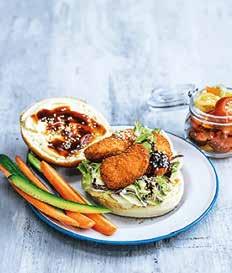
CHRISTMAS MENU INSPIRATION:
BRUSSELS SPROUTS WITH CHEESE
It’s time to swerve away from your standard cauliflower cheese recipe. This festive season, it’s the Brussels sprout’s time to shine! Opies’ indulgent recipe transforms sprouts into a rich, cheesy side dish worthy of centre stage.
RHUBARB CRUMBLE COCKTAIL
Bring a taste of festive comfort to your celebrations with Monin’s Rhubarb Crumble Cocktail – a perfect balance of tangy rhubarb and sweet crumble notes. This cosy winter serve is guaranteed to add a little seasonal sparkle to your drinks menu.
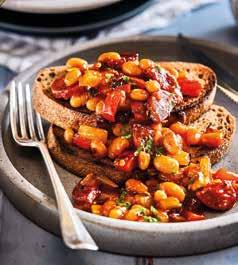


NAME: Debbie Spencer
BORN AND RAISED: Brighouse in Yorkshire but I moved to Lancashire 30 years ago
JOB TITLE: Manager
PLACE OF WORK: Inn on the Prom Hotel

HOW LONG HAVE YOU WORKED IN THE HOSPITALITY INDUSTRY? 35 years.
PASSIONS OUTSIDE OF THE KITCHEN? Gardening.
BIG TARGET FOR THE NEXT 12 MONTHS? To run our first beer festival and look at maximising our garden space for events.
WHAT IS YOUR FAVOURITE CUISINE TO EAT? Italian.
WHAT IS THE MOST ENOYABLE PART OF YOUR JOB? The people. Staff or guests - it’s all about the people.
WHO IS YOUR FAVOURITE CHEF? Gino D’Acampo.
WHAT IS YOUR TOP TIP FOR SOMEONE STARTING OUT IN THE HOSPITALITY AND CATERING INDUSTRY? Be patient and keep smiling.
WHAT DO YOU DO TO SWITCH OFF/RECHARGE? Dancing and northern soul.
WHAT AMAZING THING DID YOU DO THIS YEAR? I saw Stevie Wonder.
WHAT’S YOUR DREAM JOB? To have my own small Victorian-themed café.
WHAT IS THE LAST RESTAURANT YOU ATE IN? Turtle Bay – the prawns are amazing.
WHAT WAS YOUR LAST COCKTAIL? Passion fruit martini.
WHAT’S YOUR FAVOURITE DISH TO COOK? Roast beef.
DEAD OR ALIVE – WHICH THREE PEOPLE WOULD YOU LIKE TO COOK FOR THE MOST? Cliff Richard, Paddy McGuinness and Ant & Dec – I’m counting them as one.
WHAT IS YOUR FAVOURITE COUNTRY RANGE PRODUCT? Country Range Doughballs which we use for all our pizzas.

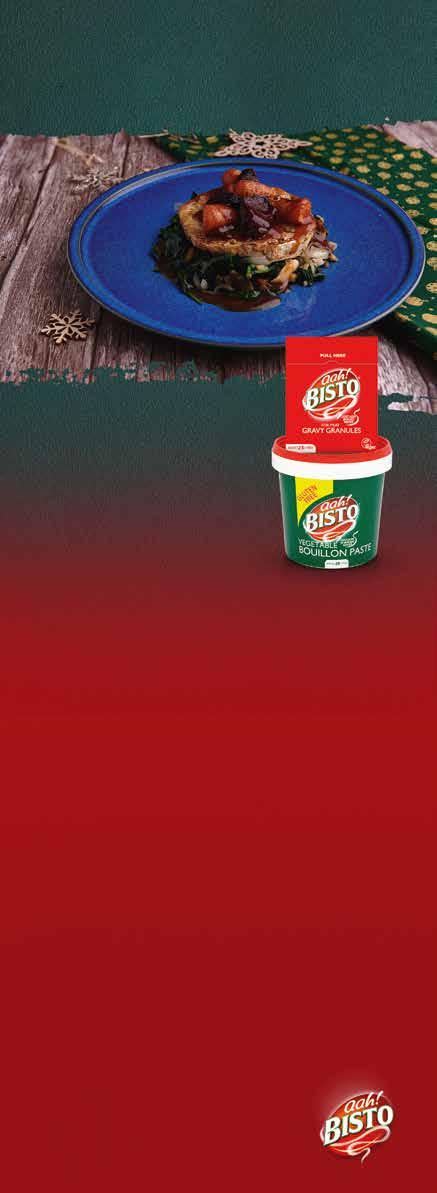
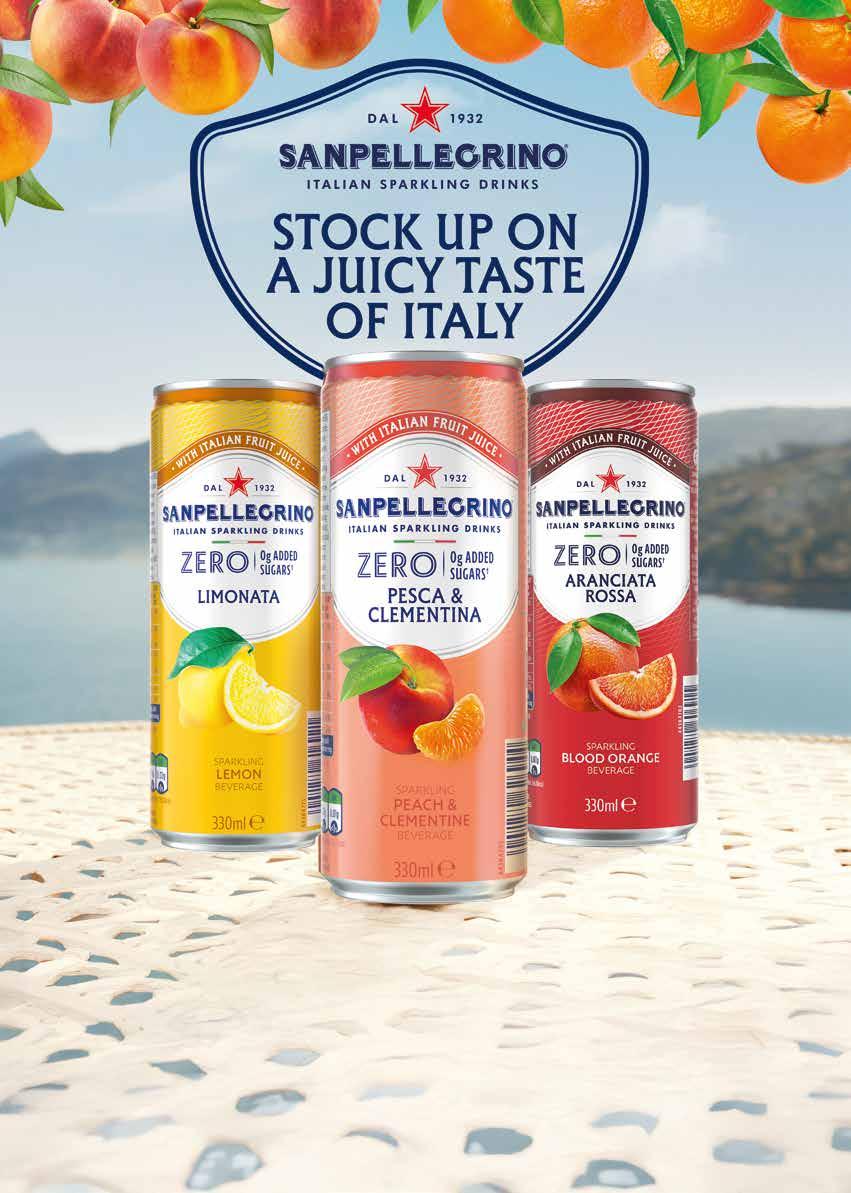


A combination of loud music, an eclectic drinks list and a dazzling daily dose of Asianinspired dishes on small plates has made Little Dumpling King a firm foodie favourite in Stoke-on-Trent. Set up by entrepreneur and head chef Rob McIntyre in 2022, Little Dumpling King celebrated its third birthday in July, and what a three years it has been with rave reviews from the likes of Jay Rayner in The Guardian and a firm place in the Good Food Guide.
After starting out working in hotels as a teenager, Rob McIntyre’s appetite for a career in food flourished while working under Rob Lamont at Artichoke in Chester. An old school bistro with a small team and 200 covers per night, it was here that Rob’s desire for the kitchen came to the boil and where he immersed himself in classical cookery techniques. From there Rob joined Laura Lautrete, aka ‘The Toastie Queen’, at the popular Chester haunt Meltdown.
“Artichoke gave me a fantastic foundation in cookery but after five years I needed to test myself,” explains Rob. “Meltdown offered me the chance to grow, push my creativity and learn new skills as it was just the two of us doing everything. Laura was and still is a great mentor as she helped me discover what it takes to run a business, not just a kitchen, and gave me the confidence to go it alone.”
“When Covid hit and we had to close the doors, Laura encouraged me to start a takeaway offering. I began with Asianinspired dumplings and I had soon found a niche - the rest grew from there. A restaurant was closing nearby so I literally knocked on the door and asked about taking the space over. Not long after that The Little Dumpling King was up and running.”
With a carefully curated menu that changes daily, Rob uses locally sourced produce alongside key Asian ingredients and a few Country Range store cupboard basics to create flavour combinations with a Bruce Lee karate kick.
“With a carefully curated menu that changes daily, Rob uses locally sourced produce alongside key Asian ingredients.”

“We combine old school cookery techniques with seasonal produce, specific Asian ingredients and a big dose of imagination to provide our unique interpretation of big Asian flavours. We make everything from scratch, right down to our very own crispy chilli oil so I like to think our food has its own distinctive personality.”
While the array of steamed dumplings has helped Rob garner a loyal local following and are worth the visit alone, Rob’s not a onedish-wonder. His creative takes on bao buns, gnarly rice bowls, steak tartare, battered chicken wings and Tom yum mussels are all huge favourites.

“I’m delighted with how things are going at present, especially considering the tough economic conditions within hospitality. Maybe in the future it would be nice to have another place where I could perhaps do small tasting menus, but my key focus for the next 12 months is to maintain what we currently have.”




Sometimes overlooked in favour of cod, their larger and more dominating relative, whiting offers great value and versatility to chefs. With the larger shoals often heading closer to the coast during winter, the next few months are often the best time for whiting, which has a delicate flavour, firm flesh and is low in fat.
This month’s seasonal inspiration comes from Head Chef Chris Hobson. Perfectly based at The View Restaurant on the coast in Scarborough, Chris is passionate about celebrating the very best sustainable seafood from British shores. It’s been a big year for Chris with various accolades and rave reviews helping to put the restaurant and his food on Yorkshire’s must-visit map.
For more information, visit https://www. delmonthotel.co.uk/restaurant.
If you have prepared whiting left over after service, utilise it by making a delicious pâté. The opportunities, combinations and options are endless. I blitz up any leftovers with a little cream cheese, chives, lemon juice and seasoning, then set it in a terrine log. Alongside some toasted sourdough, it makes a great bar snack or starter. Don’t forget to make stock from any fish bones as well.
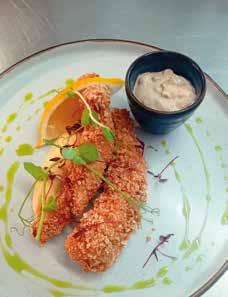

1 /
Whiting is a very versatile fish so works brilliantly battered or breadcrumbed. I love to make deep fried goujons with a Whitby brown crab mayo, baked lemon jam, pea shoots and herb oil. I like to serve it with a lemon butter sauce.
2 /
Make a tin foil parcel and layer it with fresh herbs, a squeeze of lemon juice, a grating of lemon peel and some good quality Yorkshire sea salt. Put the whiting fillets on top, seal and bake for 10-12 mins at 180oC. Serve with a zesty salad.
3 /
Poached whiting is delicately delicious but for a little extra indulgence and richness, I poach my fillets in seaweed butter. I make it using 100% kelp seaweed, which is milled down and then added to Yorkshire butter, salt and garlic.
4 /
Whiting is also a fantastic fish to flirt with global flavours. I often use it for a seafood coconut curry or Mexican fish tacos with pickled red cabbage, sour cream and chilli sauce.
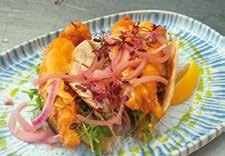
5 /
Fresh fish cooked over fire, served with salt and a squeeze of lemon takes some beating. For the best results, use a fish barbecue cage to make turning easy. You can also add herbs or a few lemon slices to the cage to accompany the fish.
Recipe images supplied by Chris Hobson
Introducing Alpen’s great new pack design and even tastier recipe! Together with its delicious crunchy roasted nuts and creamy rolled oats, Alpen now has a whopping 30% more juicy raisins! And with a big nationwide marketing campaign demand for the nation’s favourite muesli will be greater than ever, so stock up today!
Two delicious variants – Original and No Added Sugar
Tasty & nutritious**
Available in a variety of pack sizes offering convenience and value 100% recyclable packaging




The Clink, a charity which aims to reduce re-offending by training prisoners in the hospitality business, has introduced Catered by Clink. This new social enterprise delivers breakfast, lunch and canapé boxes to homes and offices throughout the country. Well known for its award-winning restaurant and bakery at HMP Brixton, The Clink also has a well-established events division, providing top end catering at large events.
Jonny Whitfield, managing director at Clink Events, says, “We often received enquiries for companies seeking catering for smaller numbers, so we knew there was an interest.”
The new initiative gives employment opportunities for inmates from Downview Women’s Prison near Sutton, Surrey, as well as students graduating from the Clink Café which is staffed by vulnerable young people at risk of becoming offenders.
“We wanted a career progression route for those people who had finished their 12-week training course at the Clink Cafe, but hadn’t had enough training or experience to work on larger events, where things are more fastpaced and complicated,” says Jonny.
“Graduates of The Clink training schemes are 60% less likely to offend when they leave prison.”
Catered By Clink supplies offices and homes with ready-to-serve sandwich and canapé platters and salads delivered in attractive presentation boxes, each for eight to 14 people. “Unlike our other events business, clients don’t need us to supply the drinks or staff. The biggest so far has been for 150 people while the smallest was 10. We started in City of London and within the M25, but companies asked for deliveries in other offices around the country and before we knew it, it was nation-wide.”
The inmates from Downview women’s prison are trained in the events business. They have between 18 to 24 months left to serve on their sentence. The Clink is an accredited City & Guilds site so the qualifications students attain are NVQ levels one, two and three and are equal to a college education.
Graduates of The Clink training schemes are 60% less likely to offend when they

leave prison. Jonny believes this is because they learn new skills, gain qualifications and are helped to find employment. “We support them every step of the way from compiling CVs, securing them with an interview with a hospitality business and helping them with the interview process. Employment is the key reason these people don’t re-offend. For some of them, it might be their first legal job.”
For the first six months an inmate leaves prison and works in a new job, The Clink keeps in touch with them and the new employer to check everything is going well.

For the employer, a Clink graduate offers many benefits. Jonny says, “Our graduates tend to be loyal and stay with employers much longer. They recognise the opportunity they’ve been given. Having stability and security in a job is amazing to them as they’ve never had it before.”
Employers have included London’s Royal Lancaster Hotel, Wahaca the Mexican food chain, the RSC Club, Institute of Directors and Benugo.
For further information, visit https://theclinkcharity.org
As Bonfire Night signals the beginning of the festive season, life is about to get a whole lot busier for chefs across the UK & Ireland. With planning also well underway for 2026, here’s some new inspiration to add to your menu.
Don’t miss our new trio of decadent pre-portioned desserts, which just need to be thawed before use, making them a time and stress saver during the busy festive season.
NEW COUNTRY RANGE CRANBERRY AND ORANGE TORTE
1 X 14 PRE-PORTIONED
A light and zesty seasonal alternative to rich desserts this festive season, this vanilla sponge is topped with Jaffa orange gel, orange cheesecake batter and a smooth cranberry swirl. Baked and finished with cranberry gel, dried cranberries and white chocolate nibs.
NEW COUNTRY RANGE CHOCOLATE BROWNIE CHEESECAKE
1 X 14 PRE-PORTIONED
This trend-busting cheesecake comprises a chocolate sponge base baked together with a sweet cheesecake, finished with a rich chocolate topping, sweet gooey brownie pieces and dark chocolate pieces.
NEW COUNTRY RANGE STICKY TOFFEE CHEESECAKE
1 X 14 PRE-PORTIONED
A classic redefined, this irresistible cheesecake includes a toffee cake base baked together with a sweet cheesecake, finished with a toffee topping, toffee cube pieces, dark & white chocolate curls and honeycomb milk coated pieces.
Country Range Cranberry and Orange Torte
Country Range Chocolate Brownie Cheesecake
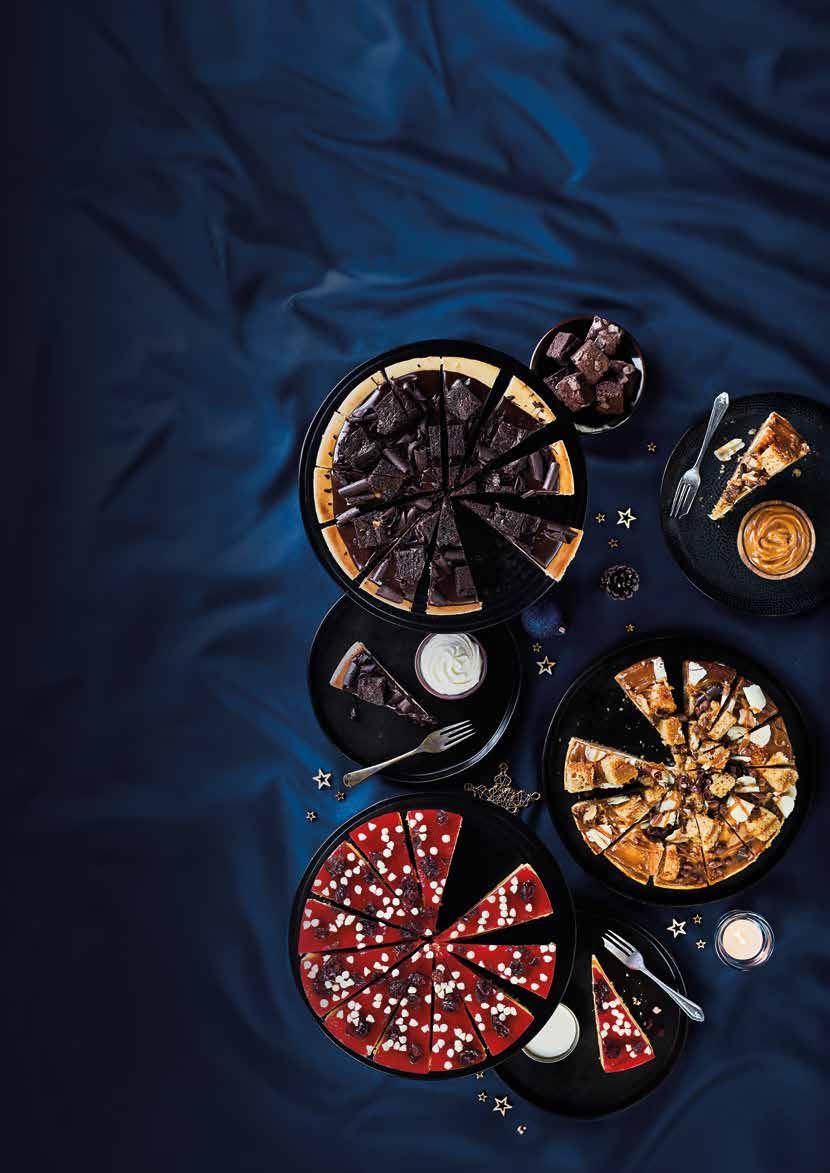
Country Range Sticky Toffee Cheesecake
SCAN HERE to see all of the recipes featured on this page


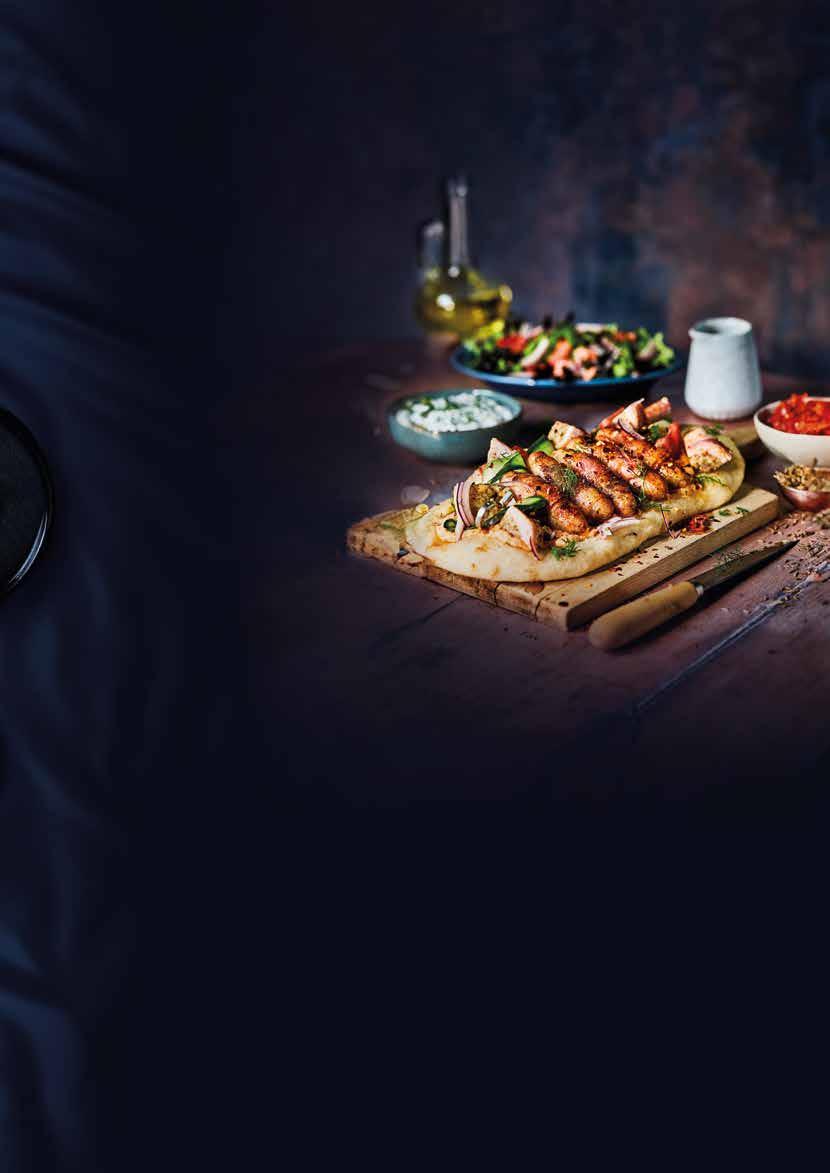


Thanks to uber-imaginative chefs and social media, the global fusion trend is continuing to push culinary boundaries. Think spaghetti tandoori, sushi pizza, teriyaki tacos or kimchi quesadillas – it’s all happening. Why not ditch the turkey sandwich and get creative with your festive leftovers with this kebab loaded with turkey, pigs in blankets and all the trimmings.
Don’t miss these time and waste savers when putting in your order for the festive season.
NEW COUNTRY RANGE TURKEY & STUFFING PARCELS
PACK SIZE: 24 X 227G
A fantastic solution that will be gobbled up in no time, this turkey escalope is filled with gluten free sage & onion stuffing and wrapped in streaky bacon. Worthy of a place on any dining table, it’s also a versatile product that can be used in various ways across the menu.
NEW COUNTRY RANGE PIGS IN BLANKETS APPROX. 5.2KG
Not just for special occasions, pigs in blankets have become roast regulars throughout the year. These new tasty gluten free chipolata sausages wrapped in smoky streaky bacon make exceptional sides, starters, bar snacks and canapés. Try giving them an international feel with a bespoke glaze, sauce or accompaniment, or smother them with on-trend hot honey.
SIGNATURE BY COUNTRY RANGE TURKEY SLICES
PACK SIZE: 6 X 500G
Sliced from a single lobe and cooked to perfection, these top-quality turkey slices have a dusting of paprika for extra flavour and are a true time and waste saving option for your Christmas dinner. With zero risk of dried out turkey breast, and no carving nightmares, you can feed a crowd with ease, as well as having perfect slices for salads and sandwiches on your lunch menu.
Looking ahead to 2026 we’re excited to announce that our cleaning products range is being given a new, fresh makeover. Introducing Clean Range Pro which will be available in February 2026 and includes all of the cleaning essentials you need to keep areas clean and safe for diners. Here’s an exclusive look just for you – keep your eyes peeled for more news from your Country Range wholesaler.









Running a gourmet truck has a number of benefits, from flexible working hours, lower start-up costs (compared to a bricks and mortar restaurant), and the opportunity to take your food direct to customers at events, parties, weddings, markets and festivals.

As we head towards the end of the year, Christmas markets are a growing opportunity for food truck operators as diners seek festive food experiences to share with friends and family.
Alan Fox, CEO of The Nationwide Caterers Association (NCASS), says, “These events can be profitable provided you choose the right ones. Try incorporating festive flavours like mulled spices, cranberry, chestnut and cinnamon into your menu. Offer warming, indulgent dishes such as gourmet burgers, loaded fries, artisan hot dogs, festive toasties, hot chocolate or mulled drinks. Pricing should reflect your ingredient quality, preparation time and event costs, while staying competitive. Plan your stock carefully to avoid food waste, especially if footfall varies day to day. Presentation is key, from branded festive packaging to music and seasonal uniforms. These all help create a memorable experience for customers.”
When choosing events, research footfall, the target audience, trading fees and who the other traders are. It is also important to build relationships with event organisers, local councils, and venue managers. Alan adds, “Make your set up stand out so customers can spot you in a busy marketplace.
“Make your set up stand out so customers can spot you in a busy marketplace.”
Use great images, give examples of your menus, talk about your brand, your experience and your accreditation such as training and being an NCASS member.”
Some festive events will be under cover, but if they are out in the open, remember the weather can be unpredictable, so make sure you’re prepared.
Dennis Broadfield has been running The Deli Truck for 13 years and now concentrates on private parties and weddings. He specialises in Texan barbecues. “This is a different way of doing a barbecue,” he says. “We slow cook a shoulder of pork so it becomes pulled pork. Everything is made from scratch and we grow our own fruit and vegetables. My advice is to understand your customers and adapt your recipes to suit what they want.”
Rashi’s Ceylon Kitchen gourmet food truck serves Sri Lankan cuisine at food festivals and private parties in Devon. “After doing some market research, we found that authentic Sri Lankan dishes were most popular, so we concentrate on that,” says Jeevan Chandrawansha, who runs the business with his wife. “Having a gourmet food truck gives you freedom to spend time with family. It’s also great to mingle with lots of interesting people.”
The biggest seller is Kottu, a Sri Lankan street food made with chopped up flatbread, vegetables and meat cooked on a griddle with spices and a curry sauce. “For Christmas, we’ll be serving Sri Lankan Christmas cakes,” he adds.
For more information, visit www.ncass.org.uk

• Research your market
• Before you trade, get legal requirements and food safety training sorted
• Keep the menu simple
• Start with small local events
• Keep an eye on portion control
• Pay attention to branding – this is as important as the food you offer
• Your choice of vehicle should fit your brand, menu and budget
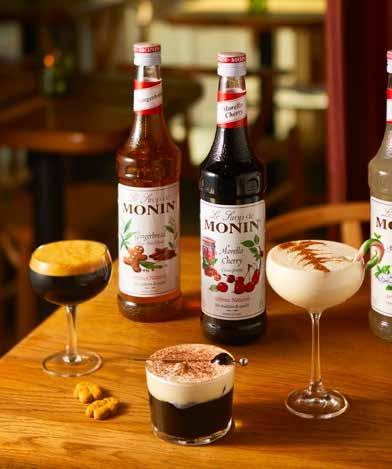


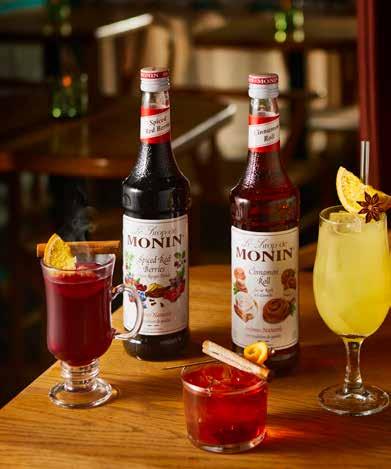






A drinks menu is more than a list of options – it’s a reflection of your brand and a key tool for influencing guest choices, boosting spend, and shaping memorable experiences. The festive season, with its sense of indulgence and excitement, presents the hospitality sector with a vital opportunity to capture profit at the close of a challenging year. Diners are far more willing to upgrade their choices during this period, and seasonal drinks such as decadent hot chocolate and festive mocktails provide the perfect reason to celebrate in style.
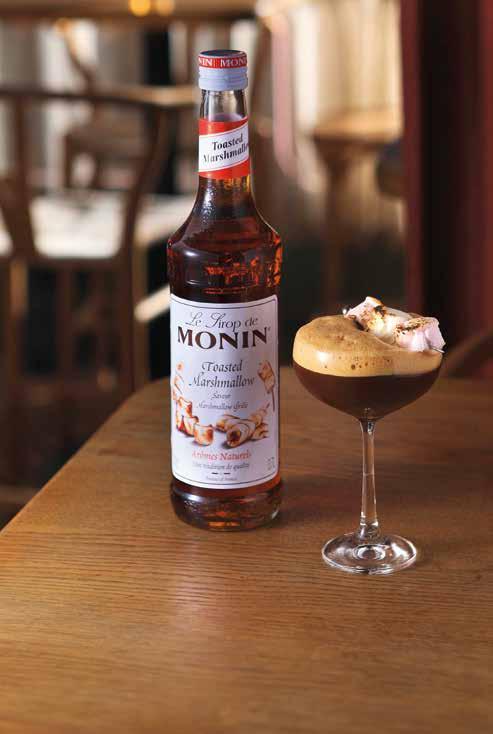
INGREDIENTS
• 20ml MONIN Toasted Marshmallow syrup
• 50ml vodka
• Double espresso
METHOD
Shake all ingredients with ice until frothy. Fine strain into a coupe and garnish with a toasted marshmallow on a skewer.
Recent CGA data highlights cocktails as a particularly strong performer over Christmas, with year-on-year sales growth of 1.6% in 2024 and a 3.3% rise in outlets serving them – the first increase since 2021. Cocktails and mocktails blend flavour, presentation, and experience, making them especially appealing, and innovation is driving demand further. “Small additions like a hint of vanilla, smoked tea or sparkling apple juice can elevate the drink,” says Julian Ebbutt, Managing Director, Anon. “The goal is a well-balanced flavour profilesweetness, acidity and spice working together - so that the mocktail feels just as exciting as an alcoholic option.”
Osvaldo Romito, Bar Manager, TRIBE recommends using house-made syrups, premium spirits and seasonal purées as well as sorbets, which TRIBE make as part of their zero-waste program. “Use premium alcohol-free spirits,
“Dessert-inspired lattés, creamy cocktails and bakeryled flavours such as toasted marshmallow, speculoos or tiramisu are driving incremental sales.”
- Iryna Apostol, Senior Trade Marketing Manager, MONIN
“Drinks should always have drama and theatre. This needs to be reflected in the presentation – spiced rim sugars, coloured ice cubes, a sprig of rosemary releasing fragrance as it warms. Add playful details like bold straws or creative stirrers.”
- Liz Taylor, CEO, Taylor Lynn Corporation
dealcoholized wine, and teas,” he says. “Add exciting garnishes and infused carbonation, and present nonalcoholic alternatives with the same care as a signature cocktail.”
Consumers are increasingly drawn to new styles and ingredients. More than a quarter of guests actively try a new drink category when ordering, showing strong appetite for experimentation –from tequila-based serves to spritzes and no-and low-alcohol alternatives.
“Ingredients with a bit of a kick, like fresh ginger, provide the warmth and ‘bite’ that many people miss from alcohol,” says Bethan Higson, CEO & Founder, Mother Root. “Acidity is also crucial for balance; something like apple cider vinegar can add a sophisticated, sharp note that cuts through richness. Finally, incorporating bitters or bitter botanicals introduces an adult complexity, moving the drink away from a simple soft drink into a genuinely satisfying, slow-sip experience.”
Presentation can be just as important as the drink itself. Research carried out by Lotus Bakeries reported that serving a complimentary biscuit alongside drinks makes 60% of customers feel more valued, with this driving loyalty amongst 87% of respondents.
“Garnishes should work harder than just looking pretty. We use them to add depth and character, like our martini which is served with a biscuit topped with rose gel that both complements the blossom vermouth in the glass and adds a subtle shimmer on top. Not every garnish has to be edible, but when it is, it gives guests another layer of flavour and theatre to enjoy,” says Ant Everett, General Manager, Side Street.

“A garnish should add to the aroma and flavour of the drink,” adds Bethan. “Instead of a simple wedge of lime, try a long citrus twist or sprig of fresh herbs, such as rosemary or mint. Dehydrated fruit wheels look beautiful and add a concentrated flavour. For warming drinks, a dusting of cinnamon or nutmeg can turn a simple serve into something truly special and multisensory.”
Garnishes are just one way to make an impact. Serving your drinks with a few table theatrics always goes down well with consumers. “For something more dramatic, try a tabletop smoker with a glass dome to create a smoked cocktail effect - it’s surprisingly easy and always impresses,” recommends Julian.
As menus are refreshed for the season, winter offers a rich palette of flavours for chefs, caterers and bar teams to explore. “Seasonal flavours such as cranberries, chocolate and spices are also key to capturing the festive spirit. Our indulgent Chocolate Martini is a great way to add a warming, luxurious treat to menus,” says Louise Wagstaffe, Senior Culinary Advisor at Premier Foods.
“Menus that evolve with the seasons not only stay current but also taste better,” agrees Ant. “We refresh ours every six months to capture produce at its peak, whether that’s tropical fruits like mango and coconut with a hit of chilli in the summer, or spices and toasted nuts when winter rolls in.”
Incorporating seasonal ingredients can be simple or highly complex, as Samet Ali, Bar Manager, Oriole, demonstrates; “We transform nuts into butters, orgeats, flavoured milks, or liqueurs - my personal favourite being a peanut butter liqueur. The by-products can then be turned into powders or used to make treats like ‘peanut brittle’ for example,” he says. “Spices are incredibly versatile too. You can create your own blends and use them to infuse syrups, liqueurs, tinctures, and bitters, or turn them into powders mixed with sugar to rim glasses or sprinkle over foamed drinks. They can even be lightly burned to add a smoky aroma.”
Not all festive drinks need to be served after dark. Cafés, schools and care caterers can seize the opportunity to create indulgent yet comforting seasonal serves. “We like to take familiar products and approach them in new ways,” enthuses Samet. “For example, one thing that we worked on recently was coffee. Instead of traditional techniques like cold brew, espresso or v60, we might ferment coffee into a coffee kombucha, bringing a fresh layer of flavour, acidity, and complexity.”
Warming milk drinks are a firm favourite at this time of year. “For a devilishly decadent Christmas delight, millionaire-layered Horlicks delivers indulgence and luxury in a showstopping drink,” says Rebekha White, Brand Manager, Amia Foods. “To make, warm chocolate sauce and pour 2cm into a clear, glass mug. Next, whisk 200ml of milk with three heaped teaspoons of Horlicks and gently add to the glass. Add caramel or maple syrup to create the third tier, before dusting with cocoa powder and garnishing with a mini millionaire shortbread square.”
“70% dark chocolate mixed with oat milk and a few bits of orange zest is my secret to hot chocolate,” says Kristy Thomas, Nutritionist, Prowise Healthcare. “But for something different for younger diners, vanilla bean or espresso shots to add depth, and peanut butter to add richness are some examples of how ice-cream milkshakes could shine.”
For 6-8 servings
• 3 eggs
• 4 egg yolks
• 2tbsp sugar
• 700ml milk
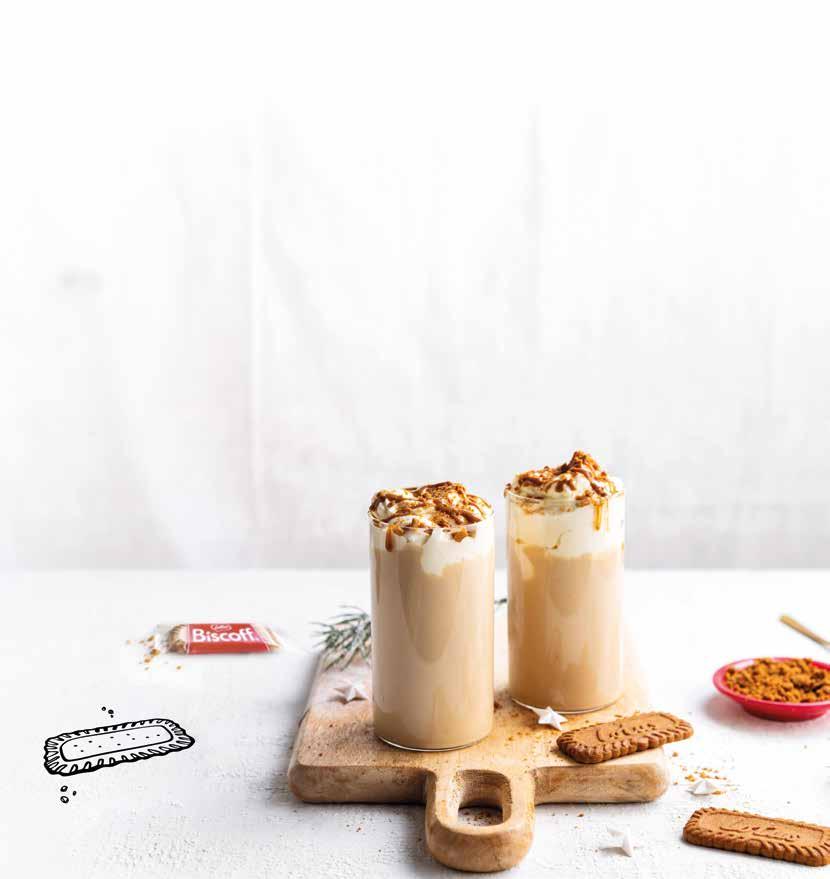
• 10tbsp Biscoff Spread
• 500ml cream
To serve:
• Whipped cream
• Biscoff crushed biscuits or Biscoff Biscuit Crumbs
• Biscoff Spread
1. Add the eggs, egg yolks and sugar in a bowl. Beat this egg mixture together until thick and pale in colour.
2. In a saucepan, bring the milk and Biscoff Spread to a simmer over medium heat, while stirring.
3. Add the warm Biscoff Spread and milk mixture, while beating with an electric hand mixer, slowly to the egg mixture. Pour the mixture back into the saucepan and cook over low heat stirring until the mixture starts to thicken.
4. Sieve the mixture and add the cream.
5. Place it in the fridge for at least 2 hours to cool completely.
6. Fill glasses with 3/4 eggnog. Top with whipped cream, crushed Biscoff biscuits, Biscoff biscuit crumbs and melted Biscoff Spread.

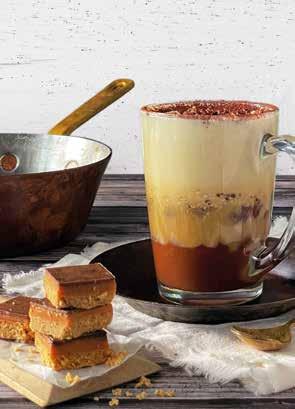

Inclusivity is increasingly important, with vegan, allergen-free and noalcohol drinks now expected as standard rather than niche. “Vegan alternatives are always part of our recipes, creating decadent textures in both cocktails and coffee drinks and are perfect for festive menus,” says Osvaldo. “We’ve found in our Grab & Go drinks, that oat and almond milks add creaminess to any type of coffee and act as a great alternative. Aquafaba is a brilliant replacement for egg whites in our cocktails, and we also use coconut cream for our Miami Vice signature cocktails to create a sketch outside the glass.”
Kirsty from Prowise Healthcare agrees that the best all all-purpose plant-based milk is oat milk, adding; “It works beautifully in frothy lattes, hot chocolates, and cocktails. Coconut cream is perfect in tropical festive beverages, but almond milk is perfect with chocolate-based drinks.”
Operators can also take advantage of vegan drink mixes to save preparation time and make service easier. “With a multi-purpose vegan drinks mix such as Iglooh, operators can whip up a whole menu of tempting vegan drinks from a single base ingredient. As a dairyfree vanilla mix which contains no artificial ingredients, Iglooh adds a naturally creamy, thick and luxurious texture to any cold, blended/mixed drink,” says Karen Green, Marketing Manager, Aimia Foods. “Also, Drink me Chai has developed a vegan blend consisting of an exotic mix of spices, soy protein and sweetened
“From showstopping cocktails to warming café creations, festive drinks are an open invitation to surprise and delight.”
black tea. It is just as easy to prepare as the non-vegan blends and still delivers the comforting flavours and textures of a traditional chai latte,” adds Rebekha.
“100% vegan, Biscoff® can be used to create decadent drinks, allowing all guests to indulge in something special this Christmas,” says Frances Booth, Head of Marketing, Lotus Bakeries. “For a unique winter warmer, Hot Biscoff® Milk is a sweet and creamy delight. To make, gently heat 250ml of oat milk and two tablespoons of Biscoff® spread in a saucepan, stirring continuously until the spread has melted. Once smooth, pour into a mug and top with a generous swirl of whipped cream, a drizzle of Biscoff® topping sauce and a sprinkling of Biscoff® crumbs.”
As demonstrated by the number of operators already making waves in the sector, from showstopping cocktails to warming café creations, festive drinks are an open invitation to surprise and delight. Make your Christmas service extra special this year with moments of comfort, theatre, and indulgence that guests will remember long after the last glass is cleared.
“People are craving new experiences – flavour explosions that spark conversation. Fat-washing with Stilton adds incredible umami depth to spirits. It’s unexpected, indulgent and seriously easy to do”
says Aidy Smith, who has worked with Clawson Farms to produce exciting new cocktails such as the Stilton Old Fashioned - Blue Maple, featuring a Stilton fat-washed Bourbon to add savoury notes of blue cheese, and the Stilton Bloody Mary, featuring a Stilton-stuffed celery stick.


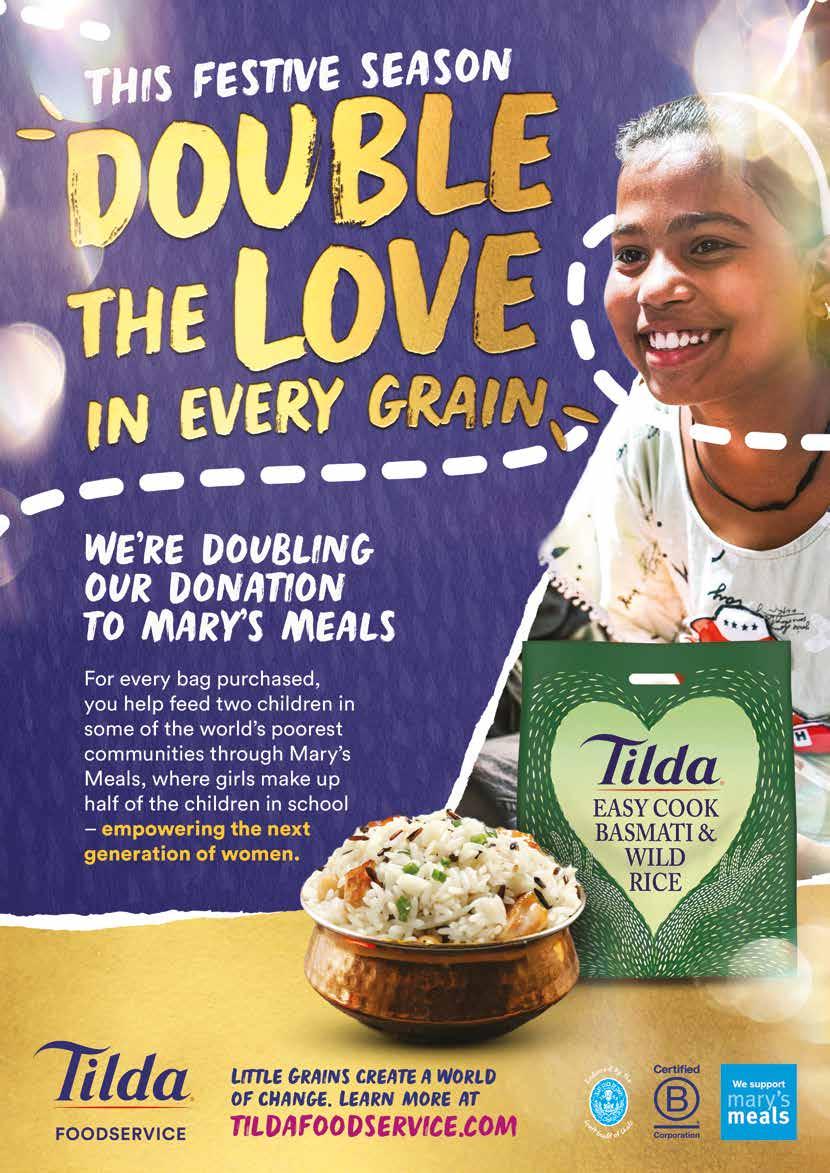


St Mary’s Catholic Primary School in Loughborough, Leicestershire, has scooped the ‘Food For Life’ Gold Award, the highest accolade in the scheme. The award confirms the fulfilment of specific criteria such as an increased uptake of school meals, encouraging students to grow and cook their own produce, as well as involving parents and the wider community.
• Roast Chicken, stuffing and gravy
• Roast Quorn fillet, stuffing and gravy (V) (VG) Both served with roast potatoes and seasonal vegetables
• Jacket potato with cheese (V), beans (VG) or tuna mayonnaise
• Assorted sandwiches served with side salad
• Lemon muffin (V)
• Custard biscuit (VG)
Priscilla Jordan, head teacher, St Mary’s Catholic Primary School, says, “We’re so delighted with this award as it recognises three years of hard work starting with the Bronze award. It’s been a team effort with children, parents and teachers being involved. We were well supported by the ‘Food for Life’ team. We’ve found that improving meals has had an impact on students’ concentration in the afternoon. If they eat better, they learn better.”
As a result of the ‘Food for Life’ programme, food waste has dramatically reduced. “Three years ago we had bins full of food waste, now it’s just a small tub,” says Priscilla.
The school has a team of student volunteers, known as eco warriors, whose mission is to reduce food waste. They put posters up around the school and encourage children with packed lunches to take their waste home. “They give the catering team feedback, so a menu is created with dishes the children want to eat to avoid food waste. If a certain dish isn’t being eaten, the eco warriors inform the catering staff.”
Growing produce is another key area. The school has established several kitchen gardens including a herb garden, a mini orchard with several apple trees and a separate growing area for each year group. “All this provides produce for the school kitchens when it’s in season,” adds Priscilla. “Students are so enthusiastic about gardening and we have a popular after school gardening club. By getting children to grow food, it encourages them to try new things. Many children won’t eat tomatoes on their own, but if they’ve grown them, they want to taste them. Cooking classes are also held using ingredients we’re growing such as a cake containing courgettes.”

To educate children about where their food comes from, visits to local farms are organised to gain first-hand knowledge. Food sensory sessions encourage children to try new fruit and vegetables, while parents were invited to workshops on healthy eating.
Looking ahead to 2026, the school will continue the new initiatives. “We will work to further increase the uptake of school meals and maintain a healthy eating menu created using the children’s feedback. We will develop the gardens to produce more food for school kitchens so we can continue teaching children about seasonal eating.”
Priscilla encourages other schools to apply for the ‘Food for Life’ Awards scheme. “It changed what we do. The support you receive from the ‘Food for Life’ team is fantastic. They helped us make connections to the local community. It’s a great scheme and they want to reward you for the hard work you put in.”
Visit https://www.foodforlife.org.uk for more information.
“We’ve found that improving meals has had an impact on students’ concentration in the afternoon. If they eat better, they learn better.”



Founder of Social Dilemma, a social media consultancy, Becky Lovelock certainly practises what she preaches. With almost 200k followers on Instagram and a further 300k on TikTok, @alittlebitoflovelock, featuring adventures with her dog Winnie has a loyal fan base. We managed to get some time with Becky to understand what makes the perfect Instagrammable space from the perspective of an influencer.

WHEN CREATING POSTS FOR @ALITTLEBITOFLOVELOCK, WHAT ARE YOU LOOKING FOR FROM A CAFÉ OR RESTAURANT TO MAKE THE POST INTERESTING?
Firstly, lighting is key - poor lighting, especially if it’s too dark, makes it difficult to capture quality content. The more niche or unique a place looks, the more likely it is to stand out and drive higher engagement online.
ARE THERE COMMON MISTAKES OPERATORS MAKE WHEN TRYING TO MAKE THEIR SPACE INSTAGRAMFRIENDLY THAT CAN DETER ENGAGEMENT?
One common mistake is going too over the top. The best spaces pick a niche and really own it, whether that’s an ‘Instagrammable’ wall feature or a signature dish that people can’t resist sharing. When you start adding too many competing features, it quickly becomes cluttered and puts people off engaging.
HOW IMPORTANT IS VISUAL STORYTELLING IN A MENU?
Taste and quality will always be the top priority, but visual storytelling definitely plays a role. If a chef is passionate and can weave creativity into the presentation - so the dish not only tastes incredible but also looks striking - it naturally performs better online. Designing with photography in mind from the start isn’t essential, but when it happens, it can really elevate a menu and create shareable moments.
DO CERTAIN TYPES OF FOOD OR DRINK PERFORM BETTER ON SOCIAL MEDIA THAN OTHERS?
Yes - things with colour, texture and a sense of craft always grab attention. Latté art, layered desserts, vibrant cocktails or anything visually striking tend to stop people mid-scroll.
HOW DO UK FOOD INFLUENCERS DECIDE WHAT TO PHOTOGRAPH AND POST?
For most, it’s a mix of aesthetics, novelty, and authenticity. It also massively depends on their niche and their audience!
Eye-catching visuals are key, but so is sharing something that feels fresh or uniquewhether that’s a beautifully plated dish, a quirky menu concept, or even a behind-the-scenes moment.
“Things with colour, texture and a sense of craft always grab attention.”
ARE THERE SUBTLE TRIGGERS IN IMAGERY OR PRESENTATION THAT MAKE A POST MORE LIKELY TO BE SHARED OR SAVED?
People also love storytelling cuesfor example, showing the ‘first bite’ moment or a cocktail being poured adds movement and relatability. Dishes that feel aspirational but still attainable are the ones most likely to be saved, because followers want to try recreating or experiencing them themselves.
HOW OFTEN SHOULD RESTAURANTS REFRESH THEIR INTERIORS, MENUS, OR PRESENTATION STYLE TO MAINTAIN INTEREST?
It really doesn’t have to be constant reinvention - small, thoughtful updates go a long way. Refreshing menus seasonally keeps things relevant, while subtle interior tweaks or new presentation styles can spark fresh interest without a full redesign.




Is it even Christmas without a turkey curry? If you regularly feature curry on your menu, it’s a great way to incorporate it into your festive specials, giving diners the opportunity to feel included in the festivities even if the traditional Christmas dinner isn’t their bag. If you want to go all out fusion, why not incorporate some spice into your Yorkshire pudding batter and serve the curry inside a giant one, which can be used instead of naan bread to mop up the sauce. Experiment with other elements of the meal, such as adding spices to your cranberry sauce to replace the mango chutney and spicing up your pigs in blankets.
‘Tis the season for turkey and all the trimmings, but if you’re investing in this versatile meat for the festive season, Paul Dickson believes that you should ensure you maximise it throughout your menu.
Everybody expects to see turkey on a Christmas menu, but it can be a big investment and it’s not always practical to serve a full roast dinner every day – particularly if you’re trying to keep your menu fresh each day in a café, education or care setting. A good turkey sandwich or curry can be a favourite memory or tradition for many at Christmas, so don’t hide them away until you’re using up what’s left, build these ‘leftover’ dishes into your core offering and hero the turkey in more ways than one.
Paul is a Home Economist and food stylist working in London and the North West, creating exceptional visual stories in film & tv, on social media and in print. All of the recipes and videos featured in the article can be accessed online at www.countryrange.co.uk/recipes or by scanning the QR Code.
If you’re using whole turkeys, please do not let the carcass go to waste. A good quality turkey stock will elevate your gravy and soup offering throughout the festive period, but it can also be portioned and frozen, ready to add flavour and nutrition to your soups and sauces throughout the winter months.
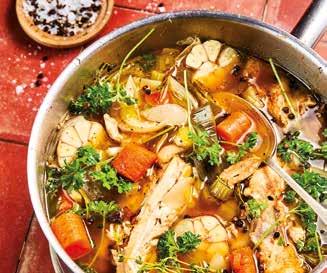
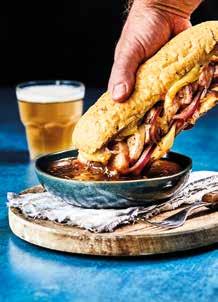
Loaded Christmas sandwich with dipping gravy

Sandwich trends are always changing, which is why it’s always a good idea to have a changing sandwich special on your menu, particularly with grab and go options becoming increasingly popular across age ranges. Make your festive sandwich the talk of the town by making it extra loaded and add a side of dipping gravy for the ultimate indulgence and upsell opportunity.

After starting out at the legendary Club 55 in St Tropez as a 16-year-old apprentice, Anthony Ekizian spent time in Michelin kitchens La Bastide Saint-Antoine and L’Arbousier in Provence, before going on to work around the world for some of the biggest names in food such as Albert Roux and Bill Granger. Now culinary director of Gaucho, we caught up with Anthony ahead of the launch of the brand’s firstever cookbook.
Tell us about your first memories of food I grew up in a big family in Provence in the south of France so my first memories sound almost fairytale like. Long tables set outside in my uncle’s big garden, filled with family and food to share.
What were the most important steps in your career development?
There were three. Firstly, my time spent at Club 55 in St Tropez. They gave me my first opportunity, saw something in me and provided the foundation that has got me where I am.
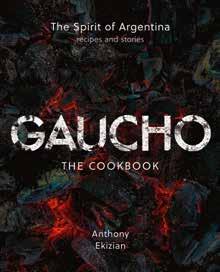

Second, my time with Philipe Troncy at L’Arbousier. It was a small kitchen, so I was learning so much and doing absolutely everything. Game, sauces, ice cream, dough – you name it. It was definitely a key stage for the development of my cookery skills and classical techniques.
Finally, my time with Bill Granger. He was a visionary and did things his own unique way. He opened my eyes to a different way of designing, plating a dish and creating atmosphere.
To win a copy of Gaucho The Cookbook, turn to page 55.
These decadent dulce de leche cheesecakes are the perfect balance of creamy, sweet and slightly tangy, with a crunchy crumble base. In the restaurant, we top our cheesecakes with luxurious Italian meringue, but we’ve simplified them here for making at home. They are ideal for an impressive dinner-party finish.
MAKES 8
INGREDIENTS
For the base
• 300g digestive biscuits
• 100g unsalted butter, melted
For the filling
• 370g full-fat cream cheese
• 170g dulce de leche
• 1 egg
• 1 tablespoon cornflour
• 3 tablespoons caster sugar
1. First, line a large baking sheet with foil and place your tart rings on top.
2. In a food processor, pulse the digestive biscuits and melted butter together until you achieve a fine, crumbly mixture. Divide the base mixture between the eight tart rings on the baking sheet, pressing it into an even layer using the back of a teaspoon. Place the baking tray in the fridge for the bases to set while you make the filling.
3. Heat the oven to 170°C/150°C fan.
4. Place the cream cheese, dulce de leche, egg, cornflour and caster sugar in a food processor. Blend until evenly incorporated and smooth.
5. Remove the baking sheet from the fridge, and spoon the filling equally into each tart ring on top of the base. Transfer to the oven and bake the cheesecakes for about 18–20 minutes, or until they are almost set but still have a slight wobble in
For the crumble topping
• 100g plain flour
• 100g caster sugar
• 100g butter
To serve
• 120g dulce de leche
You will also need 8 individual 7cm tart rings, 4cm deep.


the centre. Allow them to cool down completely (still on the baking sheet), then refrigerate until you’re ready to serve. Leave the oven on for making the crumble topping.
6. Place the plain flour, caster sugar and butter into a food processor and pulse until it resembles a crumbly mixture (be careful not to blend too much, or a dough will form). Evenly sprinkle the crumble on to a lined baking tray and bake for 14–20 minutes, or until golden brown – keep checking to avoid over-cooking. Remove the crumble from the oven and leave it to cool.
7. Once cooled, place the crumble back into the food processor and briefly pulse to a fine crumb or break it up with your fingers. Set aside.
8. To serve, remove the cheesecakes from their moulds and put each on to a serving plate. Place a small amount of dulce de leche on to each plate, then use a mini spatula, palette knife or teaspoon to create a neat smear. Sprinkle the crumble on top of the cheesecakes and serve immediately.
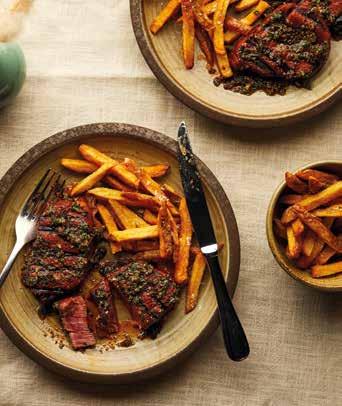

Tell us about the new Gaucho book
The book is really a celebration of over 30 years of Gaucho. It shines a light on the great chefs, recipes and spirit of Argentina that have made the brand synonymous with the best and most authentic Argentine food and hospitality in the UK.
When it comes to food – what is the spirit of Argentina?
The cuisine in Argentina is diverse and heavily influenced by Spain and Italy when it comes to how they approach food. It’s about great ingredients, simplicity and often very much about sharing. The asado plays a massive role in the daily life of many but there is a vibrant street food movement in cities where the empanadas and Choripán buns come into their own.
What’s the best part of your job?
Devising and testing new dishes with the team. I love the input and to be challenged. Young chefs see things in different ways.
Where did you last eat out?
Rambutan – Malaysian cuisine at its best. It was a great meal.
Favourite dish to cook at home?
A one pot whole chicken with olives, tomato, garlic and herbs. It’s delicious,
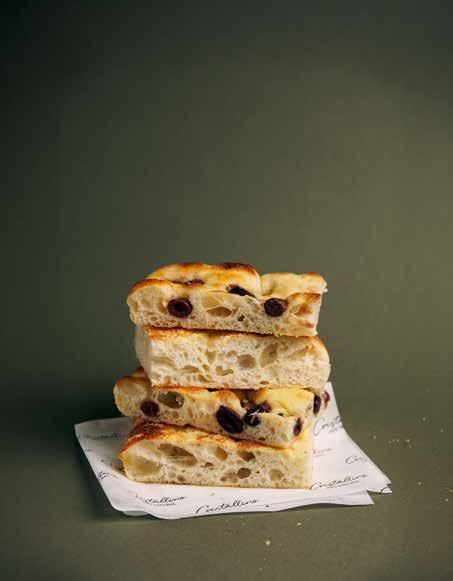
“The cuisine in Argentina is diverse and heavily influenced by Spain and Italy when it comes to how they approach food.”
easy to make and the kids love it.
Are there any new techniques or cuisines that are exciting you at the moment?
Georgian cuisine. It’s incredible and there are some really unique ingredients.
If you were Prime Minister for the day, what would you change?
A cut in VAT for hospitality businesses. It would make a huge difference. We could hire and pay more staff, which would have a positive knock-on effect.
What are your three secrets for the perfect steak?
1. Go to a butcher. Know your meat’s provenance and the cut you need for the recipe. This is non-negotiable.
2. Barbecue if you can, if you can’t - make sure the pan is very hot before you put in the steak.
3. Let it rest for 2-3 mins before serving.
Artisan bread: light, natural and crafted with olive oil and sourdough.

A world of doughnuts bursting with colour, flavour and fun in an irresistible range of formats.
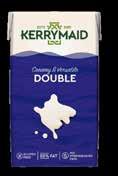



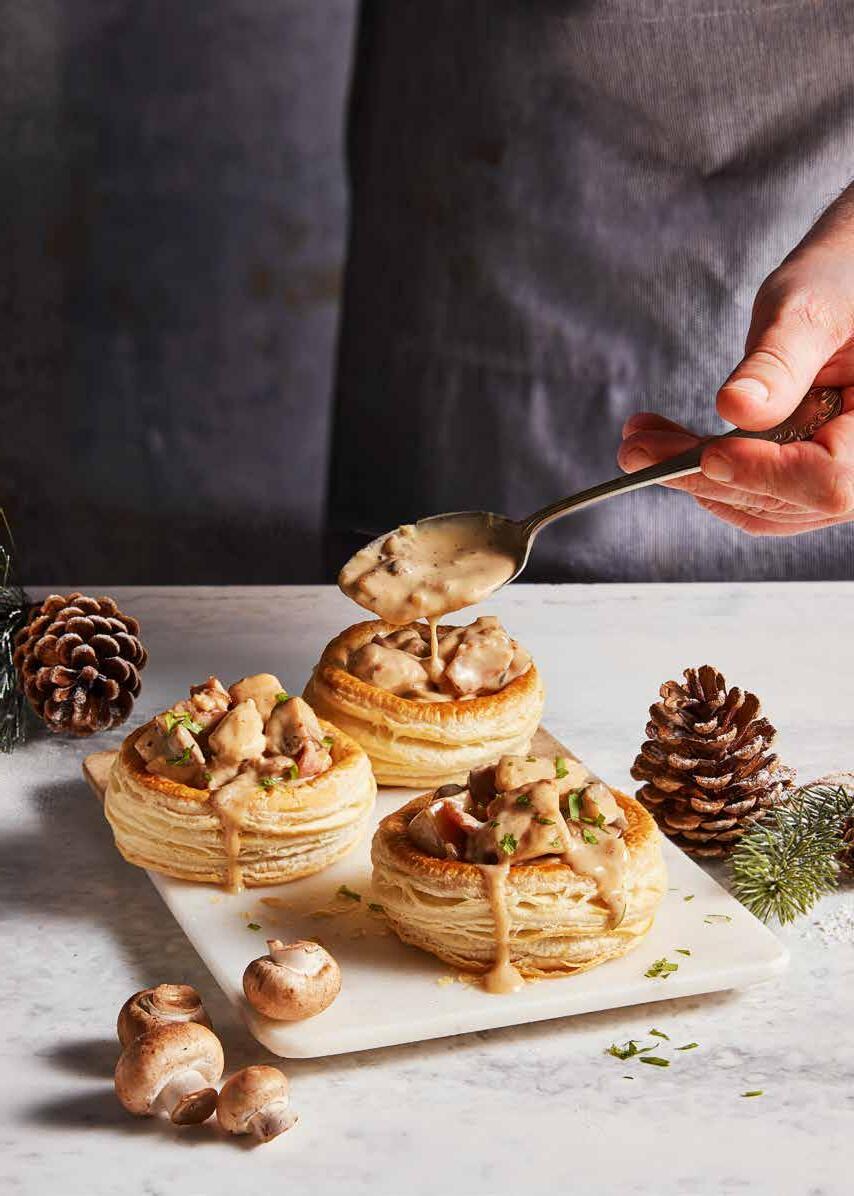





While it takes some people decades to discover where their dream career lies, Keira Roe had a plan at the age of five when she announced to her parents that she was going to be a chef. By secondary school she’d narrowed it down to pastry chef and by 16 she’d bravely left home to enrol at Birmingham’s College of Cakes, officially known as the University College Birmingham.
Swapping a village of around fifty people in the glorious Yorkshire Dales for one million people in inner city Brum, Keira showed determination and laser focus as she pursued her dreams.
“I’m from a big farming family who love to bake so there were always fresh homemade cakes and treats floating around when I was a toddler,” says Kiera. “I was hooked from an early age and I’m lucky that patisserie has been my sole passion ever since.”
Qualifying with honours from the College of Cakes, Keira then worked as a pastry chef in luxury hotels, fine dining venues and Selfridges before she started to hanker for a bakery of her own. Joining forces with her mum Patricia, who had experience in bookkeeping and running hotels, the hunt for suitable business premises began in 2018.
Based on Chesterton Fields Farm near Leamington Spa in Warwickshire, The Pinwheel Patisserie is a one-stop-shop suppling cafés, coffee shops, pubs, restaurants and event catering companies across the midlands.
“Our huge selection, which is a 50-50 split between the traditional classics and our own bespoke creations, is definitely a unique selling point. We change the menu twice a year, but we have continuous weekly and monthly specials, depending on the seasons, special occasions or what has influenced us that week.”

KEIRA AND HER MUM PATRICIA
Shortbread
• 340g Country Range Self-Raising Flour
• 225g butter
• 115g caster sugar Caramel
• 2tsp Country Range Ground Ginger
• 150g butter
• 80g caster sugar
• 150g golden syrup
• 215g condensed milk To Finish
• 70% dark chocolate
• Golden sugar stars


1. Crumb the flour, butter and caster sugar to make shortbread.
2. Press into tray and bake at 180°C for 20-25 minutes and leave to cool.
3. Make into a caramel by melting the sugar, butter and golden syrup and stirring in the condensed milk. Stir through 2 tsp ground ginger.
4. Pour the caramel onto cooled shortbread. Leave to set overnight.
5. Top with melted 70% Dark chocolate and sprinkle with golden sugar stars. Leave to set in fridge.
6. Cut into squares.
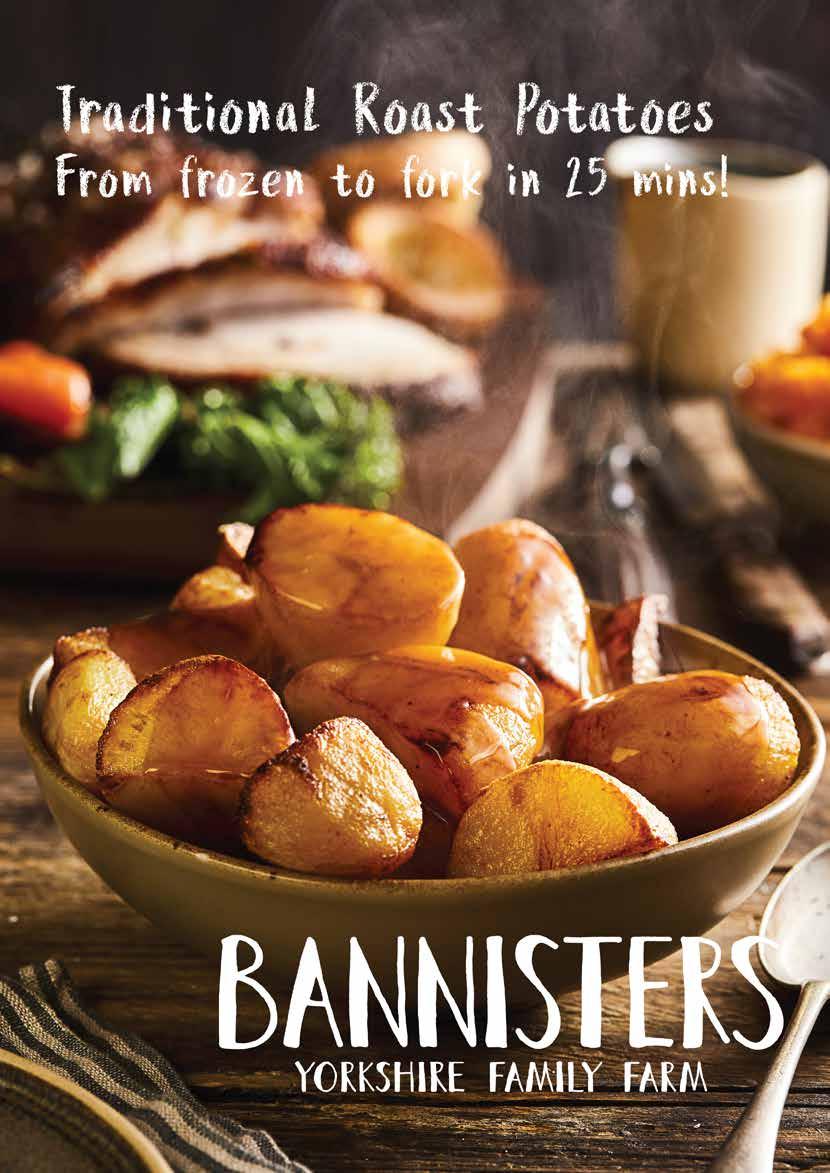
The art of re-mixing festive food leftovers into new meals is both a smart business strategy and a sustainability imperative. From reinvented sandwiches and hearty soups to inventive salads and gourmet bowls, our panel of experts give us their top tips for converting the excesses of Christmas into exciting new dishes.

SANJAY AGGARWAL
Co-Founder, Spice Kitchen
Christmas leftovers are a gift in themselves.
With a few store cupboard staples –think tinned tomatoes, coconut milk, and warming spices – you can transform them into something completely new. My go-to is Leftover Boxing Day Curry, a delicious, easy-to-prepare dish that turns turkey, roast veg or even nut roast into a Boxing Day treat. The trick is a generous spoonful of garam masala to create a rich sauce that brings new life to leftovers. Serve with fluffy rice or warm naan for the perfect second-day feast as a super-easy approach to cutting waste and to keep the celebrations going.

SOPHIE TRUEMAN
Managing Director UK & Ireland, Too Good To Go
It’s no secret that food waste at Christmas is a major issue, and research shows that over four million Christmas dinners are thrown away every year. To repurpose your roasties, mash them into a shepherd’s or fish pie, or turn leftover mash into potato pancakes with flour, eggs, milk, chives, and baking powder for a Boxing Day brunch. Brussels sprouts shouldn’t go to waste either – turn them into a delicious pesto by mixing them with garlic, lemon juice and toasted nuts.


STUART NICHOLS
Head Chef, The Ship Inn
Turn those leftover roasted root vegetables into a beautiful seasonal salad to reduce wastage and make use of the amazing Country Range larder. We dress our leftover vegetables using a dressing made with red wine vinegar and the Country Range Maple and Agave Syrup, finished with the blue maw poppy seeds, sprout tops (maximising yield, as these leaves are often discarded), toasted pecan nuts and some soft green herbs such as parsley, chive and chervil.
Make it centre stage as its own dish by crowning it with one of the beautiful sustainable fish we have available in the Southwest. I would suggest something robust and meaty like Ling or Coley which are able to compete with the strong seasonal flavours.
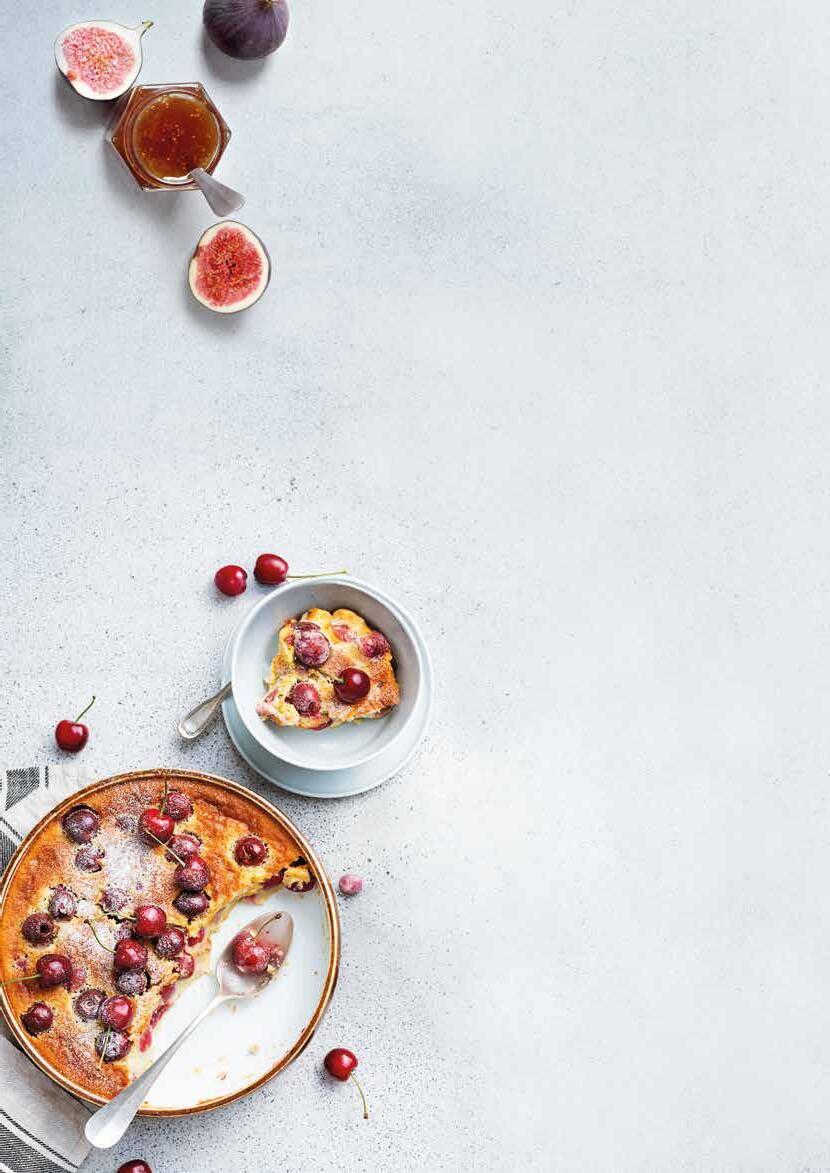

DEEPAK SHUKLA
CEO, Pearl Lemon Catering
Stock your cupboard with basic ingredients like canned tomatoes, puff pastry, and stock cubes to use up holiday leftovers. These are excellent for creating filling, tasty pies. Turkey and cranberry pie is an ideal way to use up almost all of your leftover turkey, gravy and even a few sprouts.
As far as sweet leftovers are concerned, mince pies can be used to make a quick ice cream base. Simply crumble them into vanilla ice cream and enjoy a delicious seasonal treat.

KO
Executive Chef, Chaophraya
Shredded roast turkey works beautifully in a fragrant Panang curry or a spicy Thai basil fried rice, making a fuss-free dish everyone will love. Roasted vegetables can take centre stage in a rich Massaman curry, perfect with warm roti for dipping. Even dessert can be reinvented. Crumble Christmas pudding over coconut ice cream and finish with palm sugar caramel.

PAULO RAMIAO
Head Chef & Director, El Tico Beach Cantina
My store cupboard heroes are quality stock, eggs, puff pastry, and spices (cinnamon, cumin, smoked paprika) for transforming scraps into gourmet bites. You can blend roasted veg into a spiced Butternut & Stilton Soup, and serve with crispy leftover potato rosti or cheese-topped croutons, or for a sweet re-mix, bake a Christmas Pudding Blondie by mixing chopped pudding into blondie batter.
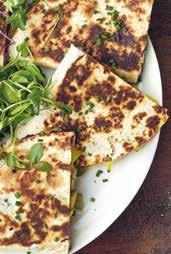
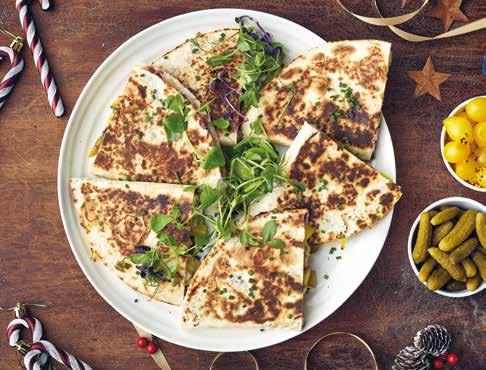

SUDHA SAHA
Chef Patreon, Spice Fusion Restaurant
I use leftover roast turkey thigh to make my spiced turkey pie with plum achar and chilli oil. First, mingle chopped turkey with gently sautéed shallots in oil, then encase it with fragrant Madras curry powder and tender coriander, creating a warmly spiced filling. On the side, make a bright plum achar by gently reducing plums with nigella seeds, vinegar, sugar, and a pinch of salt, offering a tangy counterpoint. Mash boiled potatoes with butter and cumin for a comforting, creamy base. Finally, assemble by layering the turkey mixture and mash, topping with a scoop of plum achar, and finish with a drizzle of housemade chilli oil to bring heat and shine.

ADAM CLAYMAN
Licensed RTM Manager, Bennett Opie Ltd
Blending over 140 years of flavour-making know-how and a knack for reinventing tradition, Opies know a thing or two about how to use everyday pantry staples to give classic dishes a gastronomic glow-up. Try a Ham, Vegetable & Cheese Frittata for an eezy-breezy brunch to use up leftover ham, veggies and cheese. A rich and gooey Baked Mac n’ Cheese rescues dairy excess and can be perked up with pickled walnuts and mini gherkins. My favourite is a leftover Turkey Quesadilla. It totally transforms leftover turkey and uses up the zingy cranberry sauce with complementary oozing cheesy creaminess and pop of savoury crunch from onions and gherkins.

STEPHEN GRIFFITHS
Sales & Business Development Chef, Henley Bridge
Uneaten Yule Log can be used as a base for a chocolate trifle, topped with leftover brandy cream, vanilla custard and chocolate mousse. Oranges are popular at Christmas time and any leftover fruit can be sliced and dehydrated, then ground down and used to make chocolate orange flapjacks and protein bars.
Leftover figs can be turned into jam, which is delicious served drizzled over creamy rice pudding, whilst cranberries can be transformed into a clafoutis. Simply arrange the cranberries on the bottom of an ovenproof dish then top with an eggbased batter and bake.

Made with leftover turkey, cranberry sauce and cheese and on the table in minutes!
SERVES 2
PREP TIME: 10 MINS
COOKING TIME: 5 MINS
INGREDIENTS
• 4 large tortillas
• 250g leftover Turkey meat, chopped into small cubes
• 240g Cranberry Sauce
• 100g Brie, chopped into small cubes
• 50g Mature Cheddar, grated
• 50g Mozzarella, shredded
• Salt and pepper to taste
• 1tbsp oil for frying
• ½ jar Opies Silverskin Onions, quartered
• 8 Opies Mini Gherkins, chopped
METHOD
1. Sprinkle a quarter of the cheddar and a quarter of the mozzarella onto half a side of a tortilla.
2. Next, top the cheese with a quarter of the turkey, a quarter of the onions and a quarter of the gherkins. Then spoon over with a quarter of the cranberry sauce, and finish with a quarter of the brie.
3. Fold the tortilla in half.
4. Repeat with the remaining three tortillas.
5. Heat some oil in a frying pan over a medium heat. When hot add the folded tortilla to the pan. Cook until golden on both sides and the cheese is melted.
6. Once cooked, transfer the tortillas to a chopping board, sprinkle lightly with salt whilst still hot and cut in half.


MARTYN ODELL
Owner, Lagom Chef
When it comes to turning leftovers into a pie, don’t feel you have to throw everything in together. Instead, look for pairings that really sing: turkey and stuffing, carrot and parsnip, cabbage and sausage. Build fillings around a tasty sauce - leftover gravy, a velouté, or even a bit of béchamel works beautifully.
And why stop at pies? Anything wrapped in pastry is instantly delicious. Try pasties, ham-and-cheese bakes, or spiced vegetable parcels. Toss leftover carrots and parsnips with some curry powder for something different.

NICOLA THOMAS
Owner/Chef, Vive Libre
At any time of year, croquettes are a great way of elevating leftovers into a high value dish. Classic favours like pork with stuffing and broccoli and blue cheese croquettes are always well received but the possible combinations are only limited by your imagination - Christmas pudding croquette anyone?
Although you can use the traditional rue base for the croquette - to cut out as many possible allergens as possible - I use a simple water and cornflour paste and use leftover homemade gluten free bread for my breadcrumbs. An added advantage is that a small amount of your key ingredient can go a long way. I prefer a rustic presentation but with innovative
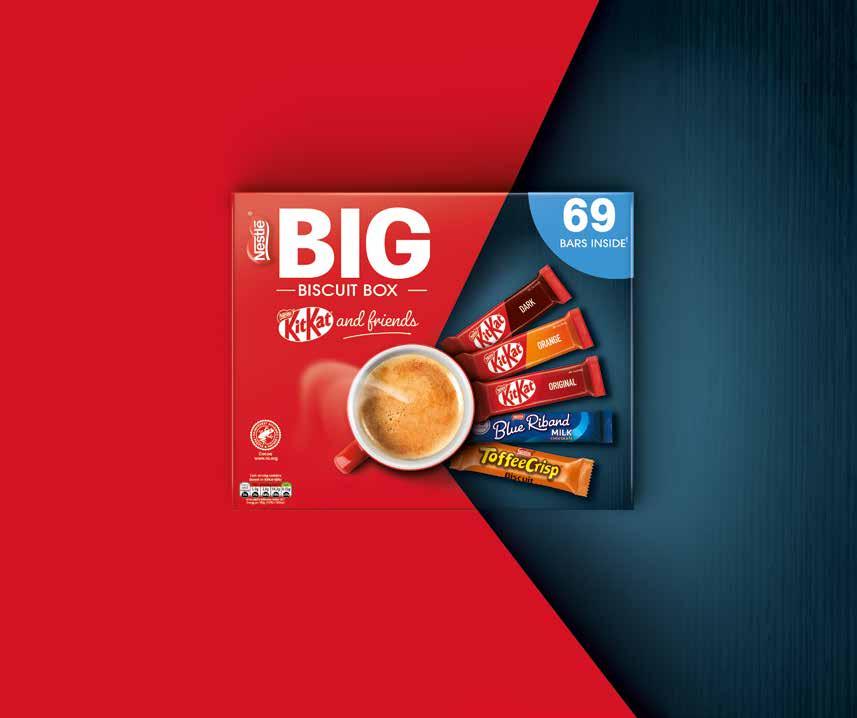




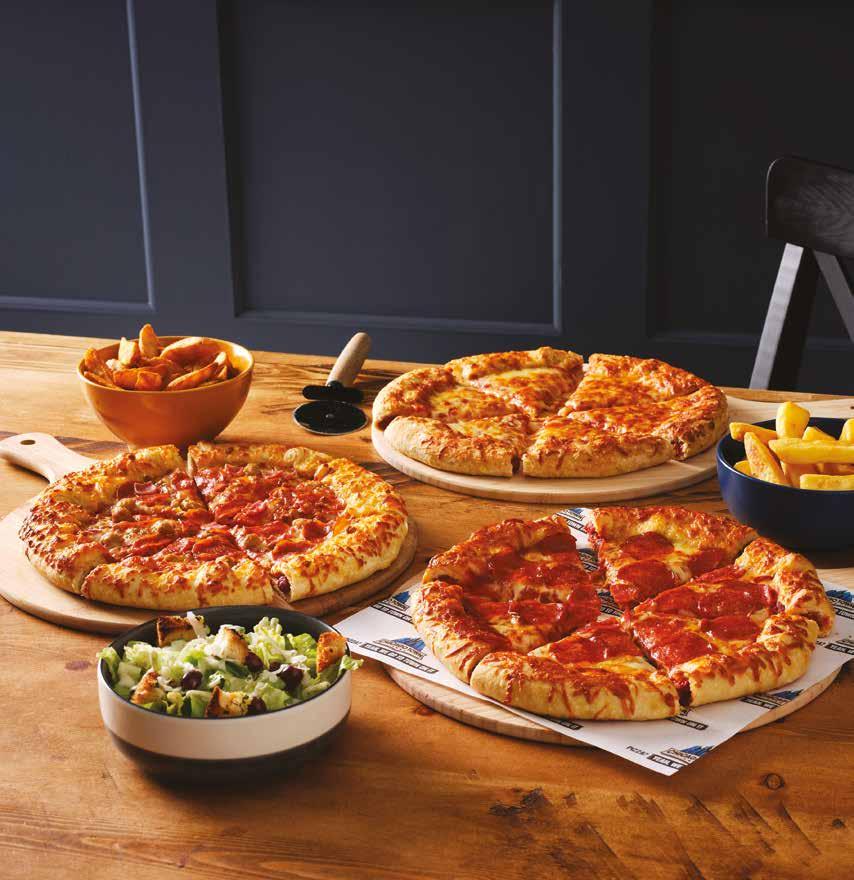
Serve it up in as little as 3 mins
Our Chicago Town Takeaway range has been crafted with our unique rising dough to create a real takeaway taste, for moments your guests won’t forget.
Discover our pizza and baking ranges and make the occasion next level.
• Use like double cream
• Looks, tastes and performs like cream
• 4hrs whipped stability
• Does not split
• Bain Marie stable



With diners increasingly mindful of the food they eat, sharing your sustainability story isn’t just a box-ticking exercise, it’s good for business. However, it must be done thoughtfully to build trust and credibility.
Menus and boards are powerful storytelling tools. But as Dame Prue Leith recently lamented, overstuffed, essay length descriptions can alienate rather than engage. Brief, clear phrases that highlight provenance and ethos work best.

At Pasture Restaurant Group, each location uses maps on their menus to show where ingredients come from, tailoring each to its community. Similarly, ‘Wahaca, Thomasina Miers’ mexican restaurant group, have have also used menus as a method of communication, adding carbon labelling, with a clear call out box explaining their sustainability efforts.
Your staff are your best advocates, so provide regular training, supplier visits, or internal updates so they can speak confidently about what makes your business green. It’s worth investing time to ensure every team member feels confident and authentic when guests ask, “And where does that come from?”
Bring guests (and the press) into your life beyond the kitchen. Simon Rogan’s “A Day at Our Farm” in the Lake District offers guided tours of his biodynamic farm,
followed by tasting menus at L’Enclume. Guests experience sustainability first-hand, and the events also attract plenty of press attention.
In Gloucestershire, The Long Table, a not-for-profit “pay as you can” restaurant, rescues food, supports staff on living wages, sources locally, and has served thousands.
These experiences turn sustainability into a dining adventure and make for great local news stories.
Local and trade press love stories with tangible impact. Whether your business has championed the responsible sourcing of fish, or your team are making waves by saving water, giving the media an authoritative angle on a topic helps to attract their attention. Similarly, using social media to communicate projects you have committed to, goals achieved, providing practical advice or regular updates will steadily build a credible reputation as a business with sustainable practices at its heart.
Ultimately, diners want proof when it comes to sustainability. Clear messaging, confident staff and tangible data all help turn your green credentials into consumer trust. Start small, tell your story with authenticity and you will be pleasantly surprised at how diners and local press respond.
Fay



Fortified
Bulk
Portion


From university student to head chef in three years, Ed Grace’s rise at Trullo has been meteoric. We caught up with the young chef as he completed his first year in the hot seat.
“I’m enjoying analysing the menu with my chefs to refine dishes. Is this the right ingredient? Could we do this better? It’s been fun to navigate that process of constant improvement and creativity.”
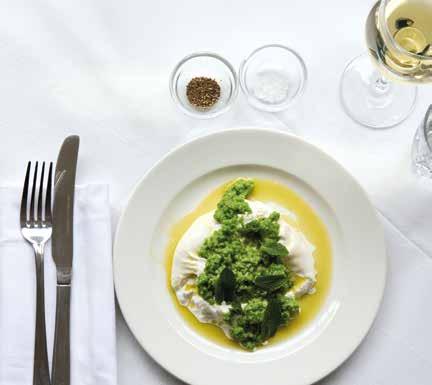

How has the journey been?
Beyond my wildest dreams. Ever since I began, it’s been a crazy ride. I celebrated my three-year anniversary at Trullo last July and have now been head chef for just over a year. It’s been awesome.
Trullo’s Burrata with smashed peas, parmesan and Amalfi lemon
Tell us about your first memories of food
I was brought up in Cambridge and I was always very fortunate that food was a big part of growing up and the centre of any family occasion. I have three siblings and every Sunday I would be fighting with them to watch Jamie Oliver and the cookery programmes instead of the cartoons. Strangely that’s my first memory. I can’t explain why really – food and cooking just fascinated me from a young age.
When did you know your career would be in food?
My siblings and I have always been big on food. When we meet up, we spend our whole time talking about cooking. Up until moving into university halls, I was quite naïve and thought that everyone had a similar relationship and love of food and cooking. It was only when I got to university that my friends pointed it out and I realised how obsessed with food I was. That prompted the question, ‘is this just a hobby or a potential career?’
I was studying history of politics, and the plan was to convert to law to do my finals but there was a growing urge to see if there was something in my passion for cookery. I decided to park my finals and try and do a gap year working in a professional kitchen. I managed to get a role at Trullo and within three days I knew that this was what I wanted to do forever.
What do you put your success down to?
I know I was probably lucky with the timing in one sense as the industry was on its knees following Covid and there were plenty of opportunities and vacancies. It meant I was given responsibility probably more quickly than I deserved, but Connor and Tim remind me that this industry is one of the only meritocracies left. If you put the hours in, learn from your mistakes, do what’s asked of you and show some passion, there are opportunities to grow and move up quickly.
How was your first year as head chef?
I have been head chef for just over a year and the first three months was very much about finding my feet and developing my style of management. I now feel a bit more comfortable in the role and have my systems in place. I’m enjoying analysing the menu with my chefs to refine dishes. Is this the right ingredient? Could we do this better? It’s been fun to navigate that process of constant improvement and creativity. It’s also nice to have ownership of how I want to channel the Trullo kitchen and building the team and getting younger chefs to develop and take ownership is very rewarding.
What is success?
Accolades are great. We got a brilliant write-up in the Financial Times last year, which justifies a lot of our hard work, but real success for me is when people keep coming back. New customers become regulars who come once a week, start coming twice, and those coming three times, start coming four times. You know you have something special when that happens. Is TV, media, books and a restaurant empire something that interests you?

Yes, possibly in the future, but I wouldn’t want to do it in place of being in the kitchen. I can’t really see myself not cooking each day. I helped Tim with the Padella book and that was an interesting process but very slow paced and different to the thrill of restaurant service.
What do you think you would miss most if you couldn’t cook professionally?
The comradery of working with a small band of chefs who become your best friends.
What’s the best advice you were given?
Control the controllables. There are so many concerns and things to worry about, you can get lost very quickly.
Control and focus on what you need to do in that moment.
Where did you last eat out?
Bouchon Josephine in Chelsea and that was without doubt the best meal I have had this year by a distance. It was really stellar French cooking in a beautiful dining room so different to Trullo. I went with my fishmonger who is a close friend, and we had a great time.
Favourite restaurant to eat?
The original Noble Rot will always have a special place in my heart. Eating out in London is so expensive and knowing the juggling it takes to write a menu, they put out an incredible set menu that is so accessible in the grand scheme of things.
Which chefs should we be watching right now?
He’s so many leagues above me and to say he’s one to watch out for sounds a pretty absurd comment but Max Coen at Dorian is literally cutting edge. Many chefs in London are an iteration of another chef and I’m not saying that’s a bad thing, but Max and his food is a complete one-off.
What’s your favourite dish to make?
One of the great pains and frustrations of working in a restaurant is that it’s difficult to get a really banging risotto on the menu. I have tried it a couple of times and it’s challenging as you have to make it to order and give it a whole lot of love. For that reason, I really enjoy making a risotto at home, slowly. Not after a shift, that would be mental, but as a nice way to wind down. You can’t really get better than a banging seafood risotto. Stock from the shells and go from there.
What are your three secrets for pasta success
• Really good ingredients is a given, but a top-quality olive oil makes a massive difference.
• Cook out your frito bases to extract maximum flavour.
• Be as simple and unabashed as possible in celebrating what you want to celebrate.
For further information visit, www.trullorestaurant.com

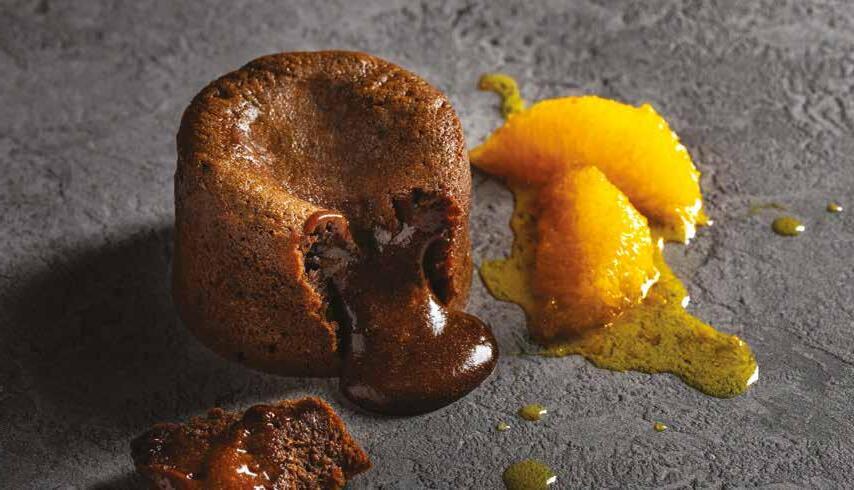


DARK CHOCOLATE ORANGE FONDANT MADE WITH SILKY 811
An elegant combination of Callebaut 811 dark chocolate and zesty orange, producing a decadent chocolate fondant that’s a must for your menus! It offers a delicious oozy centre, with the citrus balancing the deep cocoa intensity. A timeless and classic chocolate fondant with nostalgic flavours.
Brought to you by the Masters Of Taste.
Scan QR code for the
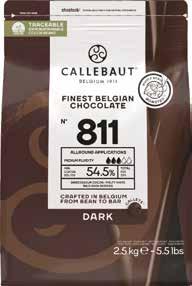

Tipiak has launched mini French country bread rolls with a Brie cheese and mozzarella filling into the UK foodservice sector. Perfect for afternoon teas, buffets, canapés, salads, soups, or cheese boards, the rolls combine two French classics—bread and cheese—for a simple yet indulgent addition to menus.
Made in Tipiak’s bakery, the rolls feature a crispy, cracked, floured crust with a soft, melting cheese centre. They reheat in just 12 minutes from frozen (8 in an air fryer), making them convenient for caterers.
Distributed via Central Foods, the vegetarian-friendly rolls are supplied in packs of 32 and add to Tipiak’s established frozen range, which includes canapés, petits fours, éclairs, and gluten-free macarons.
Marie-Emmanuelle Chessé of Tipiak said the new product reflects current dining trends and will “go down well with British consumers.”
Learn more: www.Tipiakfoodservice.co.uk
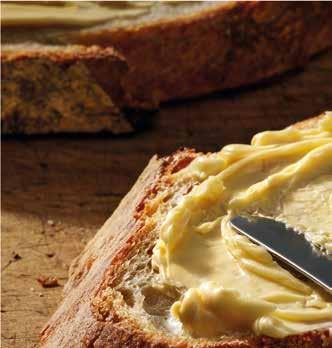
















A new YouGov survey, commissioned by ProVeg UK, shows that 46.7% of parents with children aged 3–18 support more plant-based meals in schools. The findings coincide with ProVeg’s School Plates programme reaching a milestone of 50 million meatfree or plant-based meals served across 12,000 schools since 2018.
The research also revealed strong support for education around healthy eating, with 85% of parents wanting more food and nutrition learning in schools. Parents of younger children were most likely to view plant-based meals as healthier, with support highest in London.
ProVeg UK Co-Director Sophia Millar welcomed the results, highlighting how plant-based options not only improve nutrition but also help schools lower their carbon footprint.
The School Plates initiative continues to work with over 100 catering partners, proving that plant-rich menus are both popular with parents and vital for a healthier, sustainable future.
The Phat Pasty Co has launched two new Vegetarian Society-accredited products: a Chunky Samosa Roll and a Cheese & Spinach Breakfast Turnover. The Samosa Roll, also certified vegan, combines cauliflower, chickpeas,

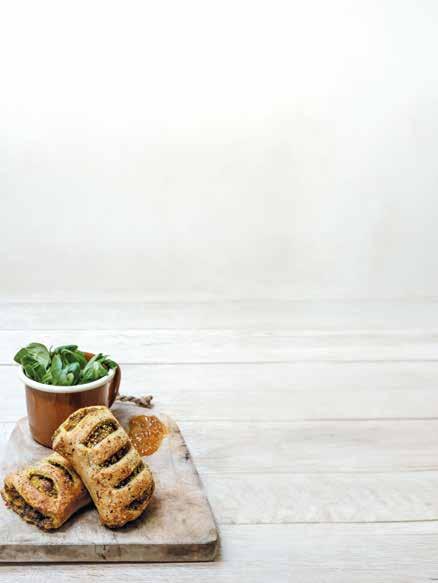
spinach, red pepper, mango chutney, and spices in a bold, plant-based format. The Breakfast Turnover offers a rich vegetarian option, filled with cheddar, Red Leicester, spinach, and béchamel sauce in puff pastry.
Supplied frozen and unbaked for easy bake-off, both products are ideal for cafés, coffee shops, and food-to-go counters.
Phat Pasty, a B-Corp and pasty category winner at the British Pie Awards 2025, has long championed plant-based innovation, with vegetarian and vegan options now making up half its range. Each plantbased product sold also supports The Word Forest Organisation, funding tree planting and community projects in Kenya.
Learn more at www.phatpasty.com
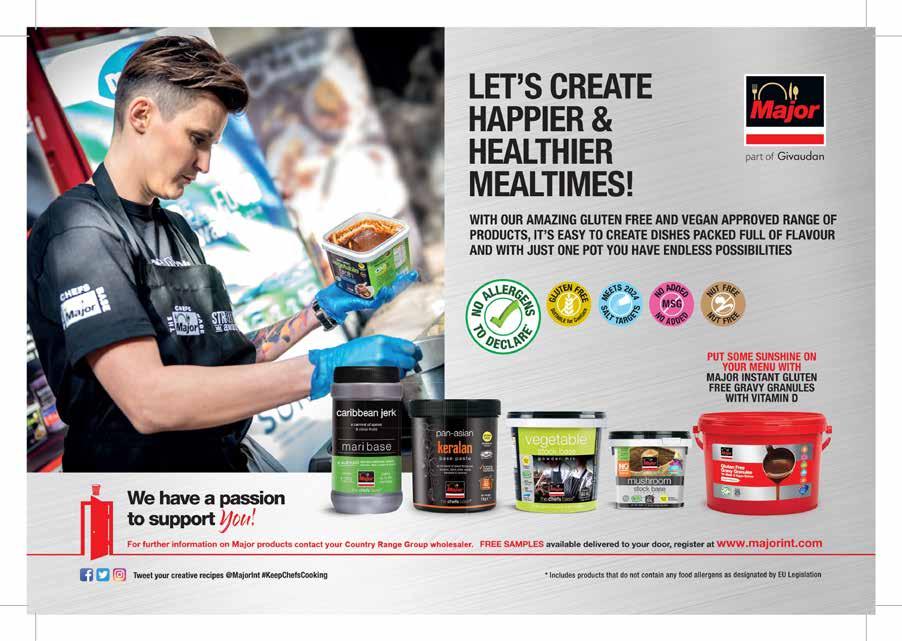
Paulig PRO, the company behind the Santa Maria brand, has launched a bold new Eastern Mediterranean range of sauces, seasonings, and pastes to help operators meet growing diner demand. Research shows 86% of UK consumers want more of this cuisine when eating out, drawn by its vibrant flavours, health benefits, and premium ingredients.
The range includes six versatile, veganfriendly products— Shawarma and Zaatar
Operators can use the products to create authentic dishes like falafel and shakshuka or to elevate mainstream options such as wraps, burgers, and loaded fries.
Paulig PRO’s new ‘Keys to Eastern Mediterranean Taste’ brochure offers inspiration, recipes, and practical menu ideas.

Springboard, the UK hospitality charity, has launched its 2025 Christmas campaign, encouraging people and businesses to swap traditional gifts for digital raffle tickets and donations that help fund career opportunities in hospitality.
For just £10 per ticket, supporters can win prizes such as dinner for four at Claridge’s with wine pairing or a two-night Hilton London Metropole stay, while giving meaningful gifts to colleagues, clients, or friends. Springboard will even send tickets with a personalised message, offering a sustainable alternative to cards and











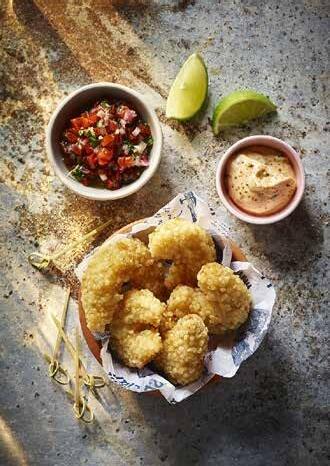


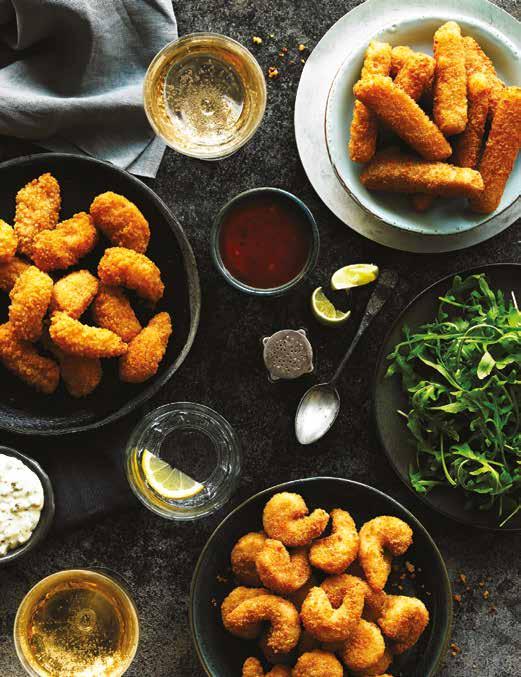



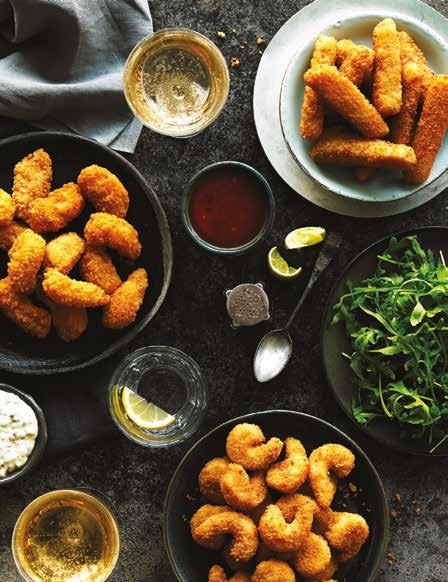




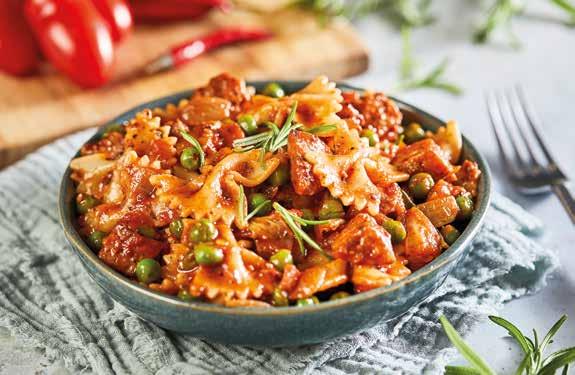
Toad in the hole is one of my favourite dishes for sausages. The fat helps to flavour the Yorkshires and it’s a simple one tray bake. Wood fire them for a sensational smoky flavour and finish.
A proper scotch egg made well is a thing of snacking beauty. I wrap my boiled eggs in bacon and sausage meat, crumb them and then smoke them slow and low over the fire. The flavour is immense.
Making your own jumbo sausages is great fun and a creative way of making your bangers unique. Use the meat from the Country Range sausages with any leftover trim from larger cuts of meat such as brisket or pork belly. You can also add you own flavours and seasonings.


This month our guest chef is the fire master Adam Purnell aka The Shropshire Lad who has amassed a huge social media following, appeared on Crazy Delicious and Masterchef and launched his own business, Embers Café, in the last decade.
Specialising in cooking, grilling and smoking over fire, here’s Adam’s scorching secrets for a fiery five-ways with our Country Range Sausages.
INGREDIENTS
• 8 Country Range Butchers Sausages, cooked & sliced
• 200g Country Range Chopped Tomatoes

• 200g Country Range Fancy Peas
• 25ml Country Range OlivePomace Oil
Bust them out of their skins and use the sausage meat alongside beef mince in your ragu or Bolognese. It adds great depth to the final sauce.
I like a bit of global fusion so enjoy using sausages for an Asian twist on a hotdog and a Vietnamese Bahn min sandwich. I call it a Bahn dawg. I cook it over the flames and then decorate with an array of toppings.

Country Range Butcher’s Style Cumberland Sausage 6’s Pack Size: 3.63kg
• 200g Country Range Farfalle Pasta
• 200g Country Range Dried Mixed Herbs
METHOD
• 1 crushed garlic clove
• 1 diced onion
• 1 diced red pepper
• 1tbsp chopped rosemary
1. Cook the onions, peppers and sliced sausages in a large pan in oil until the vegetables start to soften.
2. Add the crushed garlic, mixed herbs and chopped tomatoes and simmer for five minutes.
3. Season to taste and finish with chopped rosemary and the peas.
4. Boil the pasta until al dente in plenty of salted water and drain well.
5. Toss the pasta in the sauce and finish with the grated hard cheese of your choice. SERVES 4

Enjoy the taste, elevate the occasion. Celebrate the season with Heartsease Farm’s premium pressés, available in six delicious flavours. Served in perfectly sized 330ml cans, each one is bursting with natural taste, making them the ideal choice for festive gatherings this season.
Delicious... naturally


Request FREE trade samples


Ekizian shares stories of Argentina’s food culture, making every page as inspiring as it is delicious. A true Leading Light in gastronomy, this cookbook is the perfect
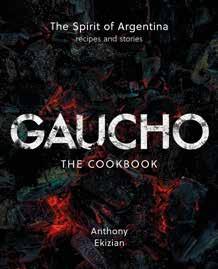


From the buttery classic to the plant-based version and the perfect mini –our range of Pastel de Nata has something for everyone.


This December, we’re excited to launch our very first Stir it up Advent Calendar – created just for you!
The front cover of this issue is your calendar. Each day, open a window, scan the QR code and enter to win an amazing prize. Entries are open for 24 hours only, so don’t miss your chance.
Expect fantastic giveaways including vouchers, chef’s knives, cookbooks, training sessions, exclusive recipes





and festive surprises. Winners will be chosen at random, giving you plenty of opportunities to bag a treat throughout the month.
Thank you to our partners
A huge thank you to the brilliant brands who helped bring this to life –your support and festive spirit made it possible!
Good luck – and Merry Christmas from Stir it up!







Two lucky winners will each receive a £100 Love2shop Gift Card, one of the UK’s best-selling and most flexible gift cards. Redeemable across 150+ high street and online retailers – from Argos and Boots to TK Maxx, Pizza Express and Waterstones - it’s like giving a world of shopping experiences in one card. Whether treating yourself to fashion, dining, beauty or books, this prize puts total choice in your hands. A perfect treat!
£100 Love2shop Gift Card!
For your chance to win, enter online or send an email titled ‘Love2shop’ along with your name, contact details and name of your Country Range Group wholesaler to competitions@stiritupmagazine.co.uk.
You can now enter all of our competitions online. Simply scan this QR code or visit www.stiritupmagazine.co.uk
Closing date for the competition is 31st December 2025. All winners will be notified by 30th January 2026. Postal entries can be sent to: Country Range Group, 4 & 5 Jupiter House, Mercury Rise, Altham Business Park, Altham, Lancashire, BB5 5BY. Full terms and conditions can be found at: www.stiritupmagazine.co.uk/about
“Tyrrellbly Tyrrellbly

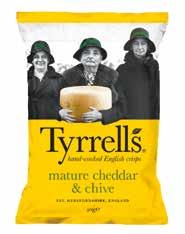






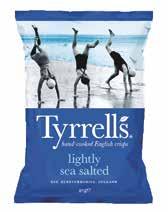

FR IE S


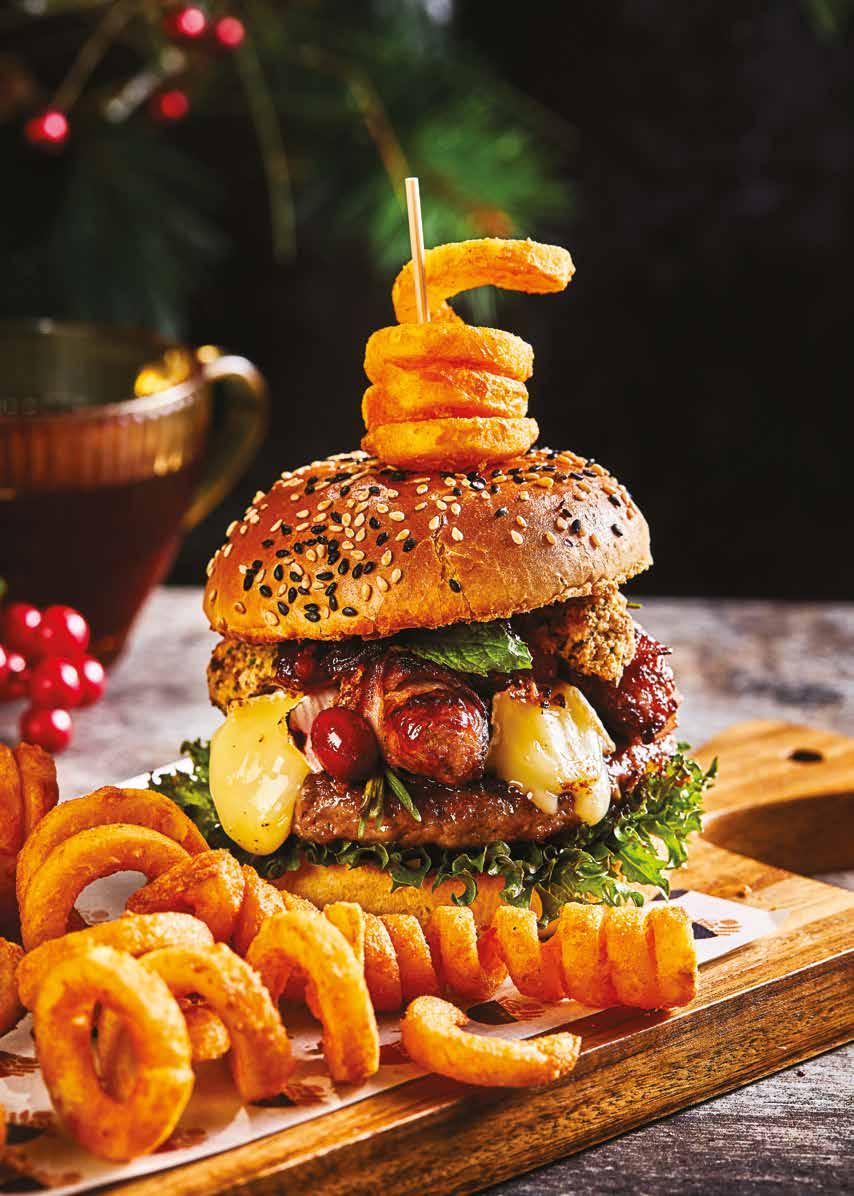

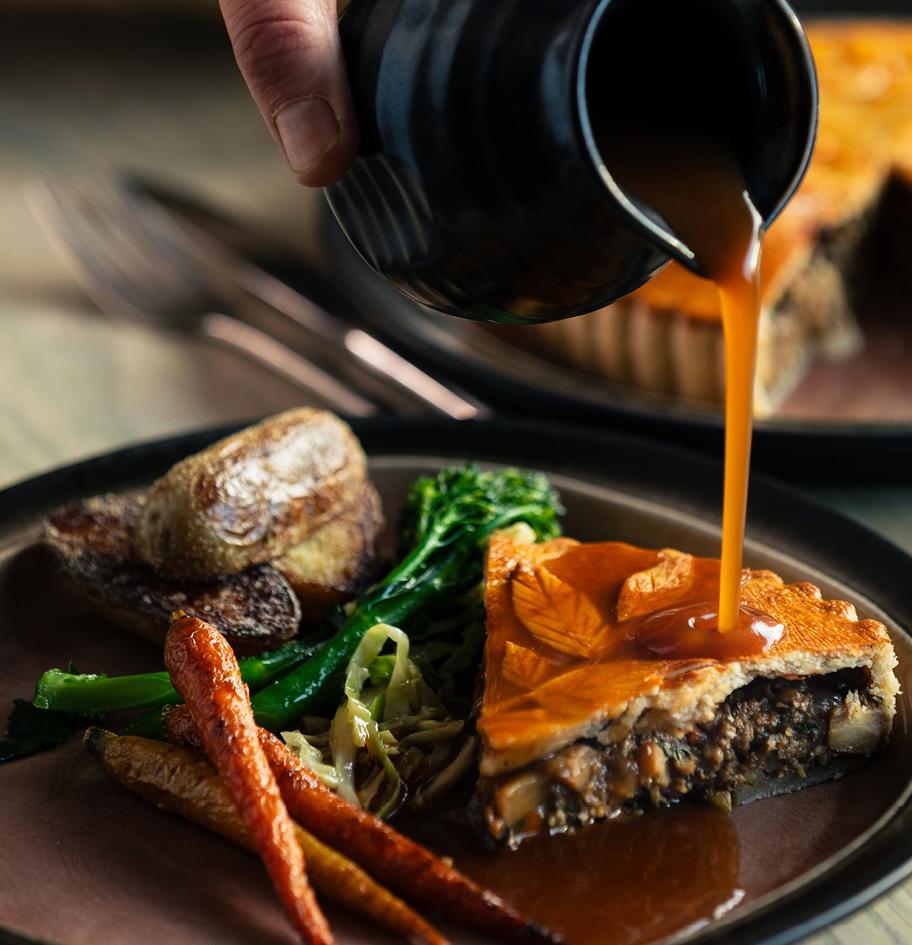

Knorr Professional

